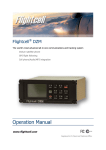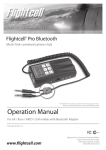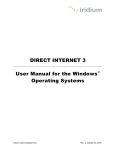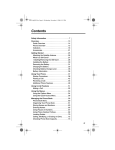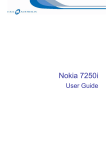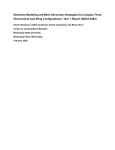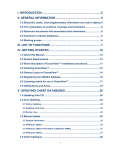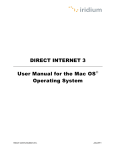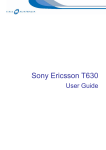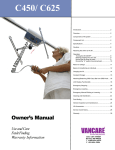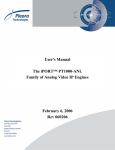Download User Manual - GC-SAT
Transcript
Flightcell® DZM2 The world’s most advanced all-in-one communications and tracking system Iridium satellite phone GPS flight following Audio/MP3 integration Unit 11 – 33 Riley Road – Woodmead + 27 11 612 3660 [email protected] www.gc-sat.com Operation Manual www.flightcell.com (English General Aviation Unit) | Version history (English General Aviation Manual) | Version history (English General Aviation Manual) Issue Date Author Description PCB Revision Issue 1 14 May 2009 A. Whitlock Firmware 3.XX Document created F | Flightcell® DZM2 Operating Manual | Firmware v3.XX Page 2 of 95 | | Contents | Contents Version history (English General Aviation Manual) ............................................................................... 2 Flightcell® DZM2 at a glance................................................................................................................... 6 Getting to know your Flightcell® DZM2 .................................................................................................. 7 Switching the Flightcell® DZM2 on and off ..................................................................................................... 8 The Flightcell® DZM2 LCD display .................................................................................................................. 9 The Flightcell® DZM2 keypad....................................................................................................................... 12 Using the Flightcell® DZM2 menu ................................................................................................................ 15 Menu Overview ...................................................................................................................................... 15 Accessing the menu................................................................................................................................ 16 Navigating the menu .............................................................................................................................. 16 Selecting a menu option ......................................................................................................................... 16 Returning to the previous screen ............................................................................................................ 16 Altering a menu setting .......................................................................................................................... 17 Saving a menu setting ............................................................................................................................ 17 Canceling a menu setting ....................................................................................................................... 17 Exiting the menu .................................................................................................................................... 17 Flightcell® DZM2 operator's guide ........................................................................................................ 18 Making and answering calls ......................................................................................................................... 19 Making a call using manual dial............................................................................................................... 19 Making a call using quick dial .................................................................................................................. 20 Making a call using the phonebook directory ........................................................................................... 21 Using touch-tone dialing (DTMF) during a call ......................................................................................... 23 Answering an incoming call..................................................................................................................... 24 Using the optional cabin phone ............................................................................................................... 24 Sending alert signals, position reports and message codes ........................................................................... 25 Sending an emergency distress signal ..................................................................................................... 25 Sending current position ......................................................................................................................... 25 Sending message codes.......................................................................................................................... 26 Using text messaging .................................................................................................................................. 29 Using the Received Messages screen ...................................................................................................... 29 Receiving a text message ....................................................................................................................... 30 Canceling unsent text messages ............................................................................................................. 30 Sending flight order number information...................................................................................................... 32 Recording and transmitting flight order number ...................................................................................... 32 Using GPS tracking...................................................................................................................................... 34 Manually transmitting GPS position ......................................................................................................... 34 Automatically transmitting GPS position .................................................................................................. 34 Using GPS antenna diagnostics ............................................................................................................... 35 | Flightcell® DZM2 Operating Manual | Firmware v3.XX Page 3 of 95 | | Contents | Using automated flight following (AFF) ........................................................................................................ 37 Registering AFF mission start and end points .......................................................................................... 37 Controlling audio settings ............................................................................................................................ 39 Accessing the Audio Menu ...................................................................................................................... 39 Setting the satellite phone audio volume ................................................................................................. 40 Setting cell phone audio volume ............................................................................................................. 40 Isolating (muting) phones....................................................................................................................... 41 Setting auxiliary device audio volume ...................................................................................................... 42 Using Flightcell® DZM2 common setup features ........................................................................................... 44 Accessing the Setup Menu ...................................................................................................................... 44 Using Auto Power On ............................................................................................................................. 44 Setting backlight brightness .................................................................................................................... 45 Setting backlight mode ........................................................................................................................... 45 Setting LCD contract............................................................................................................................... 46 Using the Installer Menu to protect advanced settings ............................................................................. 47 Identifying firmware version and serial number ....................................................................................... 48 Flightcell® DZM2 advanced setup guide ............................................................................................... 49 Configuring your Iridium satellite phone ...................................................................................................... 50 Overriding satellite phone antenna lock ................................................................................................... 50 Configuring satellite phone service center number ................................................................................... 50 Configuring GPS tracking ............................................................................................................................. 51 Accessing the Tracking Menu .................................................................................................................. 53 Enabling and disabling manual GPS tracking............................................................................................ 53 Enabling, disabling and suspending automated GPS tracking ................................................................... 54 Setting automatic GPS transmission based on time interval...................................................................... 55 Setting automatic GPS transmission based on heading change ................................................................ 56 Setting automatic GPS transmission based on low speed limit .................................................................. 58 Setting automatic GPS transmission based on collective switch position ................................................... 59 Setting automatic GPS transmission based on altitude change ................................................................. 61 Checking satellite messaging destination ................................................................................................. 62 Checking cellular messaging destination .................................................................................................. 63 Finding messaging destination addresses ................................................................................................ 64 Setting preferred messaging device ........................................................................................................ 64 Enabling messaging modes ..................................................................................................................... 65 Setting satellite message size ................................................................................................................. 67 Setting time interval for alert messaging ................................................................................................. 68 Setting GPS location upon power up ....................................................................................................... 68 Setting GPS display options .................................................................................................................... 69 Enabling and disabling automated flight following (AFF) .......................................................................... 70 Configuring advanced audio settings............................................................................................................ 72 Setting satellite phone MIC gain.............................................................................................................. 72 Setting cell phone MIC gain .................................................................................................................... 72 Setting DZM to ICS audio level................................................................................................................ 73 | Flightcell® DZM2 Operating Manual | Firmware v3.XX Page 4 of 95 | | Contents | Setting ICS to DZM audio level................................................................................................................ 74 Setting Flightcell DZM2 sidetone ............................................................................................................. 75 Switching GPS/MSG confirm tones on and off .......................................................................................... 76 Switching keypad tones on and off.......................................................................................................... 76 Configuring other Flightcell® DZM2 advanced setup features ........................................................................ 77 Setting satellite phone type .................................................................................................................... 77 Setting cellular modem type ................................................................................................................... 77 Updating Installer Menu password .......................................................................................................... 78 Using analog alarms for monitoring......................................................................................................... 79 Accessing analog alarms ......................................................................................................................... 79 Setting analog sensor low threshold ........................................................................................................ 79 Setting analog sensor high threshold ...................................................................................................... 80 Setting analog sensor timer input............................................................................................................ 81 Using digital alarms for monitoring.......................................................................................................... 81 Accessing digital alarms .......................................................................................................................... 81 Setting digital sensor mode..................................................................................................................... 82 Setting digital sensor timer ..................................................................................................................... 82 Restoring factory default settings ............................................................................................................ 83 Selecting language preference ................................................................................................................ 84 APPENDIX A: Sending text messages to a Flightcell® DZM2 ............................................................... 85 APPENDIX B: Installing and using the Flightcell® Configuration Utility ............................................. 86 About the Flightcell® Configuration Utility................................................................................................ 86 System requirements for using the Flightcell® Configuration Utility .......................................................... 86 Using the Flightcell® Configuration Utility ................................................................................................ 87 Warranty and contact details ............................................................................................................... 94 Limited warranty for your Flightcell® DZM ............................................................................................... 94 Flightcell® International contact details ................................................................................................... 94 User notes ............................................................................................................................................. 95 | Flightcell® DZM2 Operating Manual | Firmware v3.XX Page 5 of 95 | | Flightcell® DZM2 at a glance | Flightcell® DZM2 at a glance | Flightcell® DZM2 Operating Manual | Firmware v3.XX Page 6 of 95 | | Getting to know your Flightcell® DZM2 | Getting to know your Flightcell® DZM2 Learn how to: Switch your Flightcell® DZM2 on and off Read the Flightcell® DZM2 LCD display Use the Flightcell® DZM2 keypad Use the Flightcell® DZM2 menu | Flightcell® DZM2 Operating Manual | Firmware v3.XX Page 7 of 95 | | Getting to know your Flightcell® DZM2 Switching the Flightcell® DZM2 on and off | Switching the Flightcell® DZM2 on and off Switching the Flightcell® DZM2 on: If 'Auto Power On' is enabled, the Flightcell® DZM2 will automatically switch on when power supply is connected. OR to switch on manually, press the ENTER key once. NOTE! If 'Auto Power On' is disabled, you will need to press the ENTER key to switch on manually. NOTE! It may take a few seconds for the Flightcell® DZM2 to switch on. Switching the Flightcell® DZM2 off: If 'Auto Power On' is enabled, the Flightcell® DZM2 will automatically switch off when power supply is disconnected NOTE! If 'Auto Power On' is disabled, you will need to press and hold the ENTER key until the progress bar on the LCD display screen reaches the end. NOTE! Refer to "Using Auto Power On" on page 44 for further information about 'Auto Power On'. NOTE! A connected Flightcell® satellite phone cradle will switch on and off automatically whenever the Flightcell® DZM2 is switched on or off. | Flightcell® DZM2 Operating Manual | Firmware v3.XX Page 8 of 95 | | Getting to know your Flightcell® DZM2 The Flightcell® DZM2 LCD display | The Flightcell® DZM2 LCD display The LCD display screen on the Flightcell® DZM2 has Main Screen and Menu Screen modes: The 'Main Screen' displays the operating status of the Flightcell® DZM2: The satellite phone status displays on the 'Main Screen'. displays when the satellite phone is on and initializing. The satellite phone is not available for use at this time. displays when the satellite phone is powered on and connected to the Flightcell® DZM2, but it is not in use. displays when the satellite phone is dialing a clear call before a connection is established. displays when the satellite phone is connected on a clear call. displays when a call using the satellite phone is terminated at the other end or the satellite phone loses connection. displays when either the Iridium phone has been removed from the phone mount or there is no connection to the phone mount. displays when an SMS message is being transmitted. displays when an SBD message is being transmitted. NOTE! Refer to "Making and answering calls" on page 19 for further information about using the satellite phone to make and receive calls. The cell phone status displays on the 'Main Screen'. displays when the cell phone is on and initializing. The cell phone is not available for use at this time. displays when the cell phone is powered on and connected to the Flightcell® DZM2, but it is not in use. | Flightcell® DZM2 Operating Manual | Firmware v3.XX Page 9 of 95 | | Getting to know your Flightcell® DZM2 The Flightcell® DZM2 LCD display | displays when the cell phone is dialing a clear call before a connection is established. displays when the cell phone is connected on a clear call. displays when a call using the cell phone is terminated at the other end or the cell phone loses connection. Satellite phone activity indicators display on the right of the 'Main Screen'. displays when the satellite phone is powered on and ready for use. displays when the satellite phone is offline or still attempting to power on. displays satellite phone signal strength. Cell phone signal strength indicators display on the right of the 'Main Screen'. A minimum of three bars must be shown on the signal strength indicator to attempt transmission. displays at the bottom of the 'Main Screen' when satellite or cell phones are isolated (muted). NOTE! Refer to "Isolating (muting) phones" on page 41 for further information about muting phones. Automated Flight Following (AFF) status information displays at the bottom of the 'Main Screen' when AFF is switched on. displays when AFF is switched on and confirmation of AFF operation is requested from the receiving server. displays when the receiving server confirms AFF is operating. | Flightcell® DZM2 Operating Manual | Firmware v3.XX Page 10 of 95 | | Getting to know your Flightcell® DZM2 The Flightcell® DZM2 keypad | displays when AFF is switched off and confirmation of AFF termination is requested from the receiving server. displays briefly when the receiving server confirms AFF has been terminated. displays when AFF operation or termination confirmation has not been received after several attempts. Press the ENTER key to keep re-trying. displays to advise AFF operation or termination confirmation has not been received. No further automated attempts are made. NOTE! Refer to "Using automated flight following (AFF)" on page 37 for further information about AFF. flashes at the bottom of the 'Main Screen' when in Distress (Emergency) mode. NOTE! Refer to "Sending an emergency distress signal" on page 25 for further information about Distress (Emergency) mode. The 'Menu Screen' displays when you are accessing the Flightcell® DZM2 menu system: The menu system is used to view and configure Flightcell® DZM2 settings. NOTE! Refer to "Using the Flightcell® DZM2 menu" on page 15 for further information about using the menu. | Flightcell® DZM2 Operating Manual | Firmware v3.XX Page 11 of 95 | | Getting to know your Flightcell® DZM2 The Flightcell® DZM2 keypad | The Flightcell® DZM2 keypad The keypad on the Flightcell® DZM2 English General Aviation unit has various functions, as described below. Refer to each page number in brackets for further information about the key function. When the 'Main Screen' displays, each key has a quick key function: Press to call a phone number that has been entered (page 19); Press to call a quick dial number than has been selected (page 20); CONNECT key Press to call a phonebook directory number that has been selected (page 21); Press to answer an incoming call (page 24). Press to send current GPS position data for a point of interest (page MARK key 25). When on a phone call, press and hold this key to activate this function. AFF key Press to start and stop Automated Flight Following (AFF) (page 37). EMERGENCY Press and hold to start and stop an emergency distress signal (page key 25). DIAL SAT key DIAL CELL key END key Press to enter a phone number to dial from the satellite phone (page 19). Press to enter a phone number to dial from the cell phone (page 19). Press to terminate a phone cal (page 19)l; Press to undo last action and return to the 'Main Screen'. MR1 key Press to dial the phone number saved as quick dial 1 (page 20). MR2 key Press to dial the phone number saved as quick dial 2 (page 20). | Flightcell® DZM2 Operating Manual | Firmware v3.XX Page 12 of 95 | | Getting to know your Flightcell® DZM2 MR3 key MESSAGES key DIRECTORY key The Flightcell® DZM2 keypad | Press to dial the phone number saved as quick dial 3 (page 20). Press to view received messages (page 29). When on a phone call, press and hold this key to activate this function. Press to select a number from the phonebook directory (page 21). When on a phone call, press and hold this key to activate this function. Press to isolate (mute) audio between the Flightcell® DZM2 and the ISOLATE key satellite or cell phone (page 41). When on a phone call, press and hold this key to activate this function. CANCEL key Press to delete numbers shown on the display, undo last action and return to previous screen. Press to enter the menu system to configure Flightcell® DZM2 settings MENU key (page 16). When on a phone call, press and hold this key to activate this function. ENTER/POWER key Press, or press and hold, to switch the Flightcell® DZM2 on or off (page 8); Press to select an option highlighted on the screen. When the 'Menu Screen' displays, the following key functions are available: Press the up and down arrow keys to navigate through the menu ARROW keys options (page 16). Press the left and right arrow keys to increase or decrease Flightcell® DZM2 settings (eg. volume or level setting) (page 16). Press the 3 key to move directly to the first item in a menu list (page MENU LIST 16). QUICK keys Press the 9 key to move directly to the last item in a menu list (page 16). ENTER key CANCEL key Press to select a menu item (page 16); Press to save modified settings for a selected menu item. Press to delete numbers shown on the display, undo last action, cancel any unsaved settings and return to previous screen. | Flightcell® DZM2 Operating Manual | Firmware v3.XX Page 13 of 95 | | Getting to know your Flightcell® DZM2 END key The Flightcell® DZM2 keypad | Press to exit the menu system, undo last action and return to the 'Main Screen'. When dialing calls, the following key functions are available: DIGIT keys + key Press the 0 to 9 digit keys to dial a phone number. Press and hold for the international dialing prefix "+" (for GSM and Iridium networks only) (page 19). Press to call a phone number that has been entered (page 19); Press to call a quick dial number than has been selected (page 20); CONNECT key Press to call a phonebook directory number that has been selected (page 21); Press to answer an incoming call (page 24). ENTER key Press to dial a phone number that has been entered. END key Press to end a call (page 19). * key # key Use to enter * symbol during a call when touch-tone dialing is required (page 23). Use to enter # symbol during a call when touch-tone dialing is required (page 23). | Flightcell® DZM2 Operating Manual | Firmware v3.XX Page 14 of 95 | | Getting to know your Flightcell® DZM2 Using the Flightcell® DZM2 menu | Using the Flightcell® DZM2 menu The menu system is used to access and configure a wide range of Flightcell® DZM2 settings. Menu Overview The Flightcell® DZM2 menu layout is shown in the diagram below. Refer to the page number displayed in brackets for more detailed information about each menu option. NOTE! Refer to "Using the Installer Menu to protect advanced settings" on page 47 for further information about how to protect critical settings. | Flightcell® DZM2 Operating Manual | Firmware v3.XX Page 15 of 95 | | Getting to know your Flightcell® DZM2 Using the Flightcell® DZM2 menu | Accessing the menu Press the MENU key to enter the menu system. NOTE! When in the menu system, the Flightcell® DZM2 will automatically return to the 'Main Screen' after 30 seconds unless another key is pressed. Navigating the menu In the menu system, press the or arrow keys to move up and down the menu options. Press the quick key to move directly to the first item in the menu list. Press the quick key to move directly to the last item in the menu list. Selecting a menu option Press the ENTER key to select a highlighted menu option. Returning to the previous screen Press the CANCEL key to deselect a menu option and return to the previous screen. | Flightcell® DZM2 Operating Manual | Firmware v3.XX Page 16 of 95 | | Getting to know your Flightcell® DZM2 Using the Flightcell® DZM2 menu | Altering a menu setting Press the arrow key to increase a setting (eg. a volume or level setting). Press the arrow key to decrease a setting (eg. a volume or level setting). Saving a menu setting Press the ENTER key to save modified settings for a selected menu item. Canceling a menu setting If a menu setting has not been saved: Press the CANCEL key to cancel the change and return to the previous screen. OR press the END key to cancel the change and exit the menu system. Exiting the menu Press the END key to exit the menu system and return to the 'Main Screen'. NOTE! When in the menu system, the Flightcell® DZM2 will automatically return to the Main Screen after 30 seconds unless another key is pressed. | Flightcell® DZM2 Operating Manual | Firmware v3.XX Page 17 of 95 | | Flightcell® DZM2 operator's guide | Flightcell® DZM2 operator's guide Learn how to: Use the Flightcell® DZM2 functions that are often required by the pilot during flight. NOTE! Refer to "Flightcell® DZM2 advanced setup guide" on page 49 for further information about how to configure advanced Flightcell® DZM2 settings. | Flightcell® DZM2 Operating Manual | Firmware v3.XX Page 18 of 95 | | Flightcell® DZM2 operator's guide Making and answering calls | Making and answering calls Making a call using manual dial You may manually enter phone numbers into the Flightcell® DZM2 to make an audio call. STEP 1 - Selecting to make a call using the satellite phone or cell phone: From the 'Main Screen', press one of the following keys: Press the DIAL SAT key to make a manual call from the satellite phone. DIAL CELL key to make a manual call OR press the from the cell phone. The 'Phone Number Select' screen displays. STEP 2 - Entering the phone number: From the 'Phone Number Select' screen, press the "0" key to enter a new number. Using the 0 to 9 keys, enter the phone number. Press and hold the MENU key to enter the international dialing prefix "+" (GSM and Iridium networks) OR press the "0" key where the "0" number is required. Use the CANCEL key to delete (backspace) any digits entered if required. The phone number entered will display. | Flightcell® DZM2 Operating Manual | Firmware v3.XX Page 19 of 95 | | Flightcell® DZM2 operator's guide OR press the Making and answering calls | DIAL SAT or DIAL CELL keys ENTER key to redial the last number followed by the called. STEP 3 - Dialing the number: Press the CONNECT key to dial the number. The phone status on the 'Main Screen' displays Calling. When the call is connected the phone status displays On Call. NOTE! It may take up to 30 seconds for the satellite phone being called to respond. NOTE! If the call is canceled before connection, the phone status displays Disconnecting before returning to Idle. STEP 4 - Terminating the call: Press the END key to terminate a call at any time. The phone status returns to Idle. NOTE! The call will also be terminated if the party at the other end of the audio link hangs up. Making a call using quick dial You may manually enter phone numbers into the Flightcell® DZM2 to make an audio call. STEP 1 - Selecting to make a clear or secure call: From the 'Main Screen', press one of the following keys: Press the DIAL SAT key to make a manual call from the satellite phone. OR press the DIAL CELL key to make a manual call from the cell phone. | Flightcell® DZM2 Operating Manual | Firmware v3.XX Page 20 of 95 | | Flightcell® DZM2 operator's guide Making and answering calls | The 'Phone Number Select' screen displays. STEP 2 - Selecting the number from the phonebook directory: From the 'Phone Number Select' screen, press the or quick select memory redial key. The name and/or number details will display. "Entry Empty" will display if the quick select memory redial key entry is blank. OR press and hold the ENTER key to call the last dialed number. STEP 3 - Dialing the number: Press the CONNECT key to dial the number. The phone status on the 'Main Screen' displays Calling. When the call is connected the phone status displays On Call. NOTE! It may take up to 30 seconds for the satellite phone to respond. NOTE! If the call is canceled before connection, the phone status displays Disconnecting before returning to Idle. STEP 4 - Terminating the call: Press the END key to terminate a call at any time. The phone status returns to Idle. NOTE! The call will also be terminated if the party at the other end of the audio link hangs up. Making a call using the phonebook directory The Flightcell® DZM2 can quickly dial phone numbers stored in the phonebook directory. | Flightcell® DZM2 Operating Manual | Firmware v3.XX Page 21 of 95 | | Flightcell® DZM2 operator's guide Making and answering calls | NOTE! The phonebook directory is managed using the Flightcell® DZM Configuration Utility. Refer to “APPENDIX B: Installing and using the Flightcell® Configuration Utility” on page 86 for further information about the Flightcell® DZM Configuration Utility. STEP 1 - Selecting to make a call using the satellite phone or cell phone: From the 'Main Screen', press one of the following keys: DIAL SAT key to make a manual call from Press the the satellite phone. OR press the DIAL CELL key to make a manual call from the cell phone. The 'Phone Number Select' screen displays. STEP 2 - Selecting the number from the phonebook directory: From the 'Phone Number Select' screen, press the DIR key. The phonebook directory 'Browse' screen displays. Press the or arrow keys to move down and up the directory entries to locate the desired entry. "Entry Empty" will display if the phonebook directory entry is blank. NOTE! This phonebook directory screen will show the name of the contact for each phonebook entry. If no name is recorded it will show the phone number. Press the ENTER key. The full name and number details recorded for the phonebook directory entry will display. STEP 3 - Dialing the number: Press the CONNECT key to dial the number. The phone status on the 'Main Screen' displays Calling. When the call is connected the phone status displays On Call. NOTE! It may take up to 30 seconds for the satellite phone to respond. | Flightcell® DZM2 Operating Manual | Firmware v3.XX Page 22 of 95 | | Flightcell® DZM2 operator's guide Making and answering calls | NOTE! If the call is canceled before connection, the phone status displays Disconnecting before returning to Idle. STEP 4 - Terminating the call: Press the END key to terminate a call at any time. The phone status returns to Idle. NOTE! The call will also be terminated if the party at the other end of the audio link hangs up. Using touch-tone dialing (DTMF) during a call Dual-tone multi-frequency (DTMF) signaling, commonly known as touch-tone dialing, uses key tones to signal to automated operator services and some PABX systems. Common examples of where DTMF signaling is used are when selecting choices from telephone menus of call centers, using phone banking, etc. When on a call, DTMF is shown on the top line of the display. This indicates that DTMF signaling is available. When on a call, the number keys and the # keys on your Flightcell® DZM2 may be * and used to send DTMF tones when required. NOTE! When on a phone call you need to press and hold the EMERGENCY, MESSAGES, ISOLATE and MARK, AFF, MENU keys to use their quick key functions. | Flightcell® DZM2 Operating Manual | Firmware v3.XX Page 23 of 95 | | Flightcell® DZM2 operator's guide Making and answering calls | Answering an incoming call The Flightcell® DZM2 can receive incoming calls through the satellite phone. STEP 1 - Incoming call detected: When the Flightcell® DZM2 detects an incoming call on the satellite phone, an alert displays on the LCD screen. STEP 2 - Answering the call: Press the CONNECT key to answer the incoming call. The phone status displays On Call. STEP 3 – Rejecting or terminating the call: Press the END key to terminate a call at any time or to reject the call. The phone status returns to Idle. NOTE! The call will also be terminated if the party at the other end of the audio link hangs up. Using the optional cabin phone A standard corded or cordless phone can be installed in the aircraft cabin for passenger use. This is connected to the DZM2’s SLIC (Subscriber Line Interface Connection). Making an outgoing call from the cabin phone: To make a call on the cabin phone, dial as you would a normal international call, using the international dialing prefix 00. For example, to dial a number in the United States, dial 001 – area code – phone number. The Flightcell® DZM2 is configured to provide privacy to the party making the call from the aircraft. If the cabin phone is in use, the Flightcell® DZM2 shows “Passenger using phone; Press END to to hang up". The crew connected to the Flightcell® DZM2 using their headsets cannot hear the conversation. If the crew need to use the phone urgently, they can press the End key to terminate the passenger’s call. If the crew are using the Flightcell® DZM2, then the cabin phone gives a “Busy” tone, preventing the use of the cabin phone by any other party. | Flightcell® DZM2 Operating Manual | Firmware v3.XX Page 24 of 95 | | Flightcell® DZM2 operator's guide Sending alert signals, position reports and message codes | Sending alert signals, position reports and message codes Sending an emergency distress signal In emergency, a distress signal may be transmitted using the Flightcell® DZM2. In distress mode, the Flightcell® DZM2 transmits position data with a distress tag attached at selected time intervals. The receiving server identifies the distress signal and automatically raises an alarm, alerting nominated parties by text message, page or email. NOTE! An appropriately configured receiving server is required to receive distress signals and alert nominated parties. NOTE! Refer to "Setting time interval for alert messaging" on page 68 for further information about setting the time interval for alert messaging. STEP 1 - Transmitting an emergency distress signal: From the 'Main Screen', press and hold the EMER key to send an emergency distress signal. flashes at the bottom of the LCD 'Main Screen' when in emergency distress mode. STEP 2 - Switching emergency distress signal off: From the 'Main Screen', press and hold the EMER key to return to normal mode. NOTE! If the Flightcell® DZM2 was escalated from under fire alert mode directly into emergency distress mode, it will return to under fire alert mode when the emergency distress signal is switched off. Sending current position Your current GPS position may be manually transmitted at any time. NOTE! Manual position must be enabled to manually transmit your GPS position. Refer to "Enabling and disabling manual GPS tracking" on page 53 for further information about enabling and disabling various manual sending modes. NOTE! Refer to "Sending message codes" on page 26 for further information about how to attach message codes to manual GPS position reports. NOTE! Refer to "Automatically transmitting GPS position" on page 34 for further information about sending automatic GPS position reports based on specified factors. | Flightcell® DZM2 Operating Manual | Firmware v3.XX Page 25 of 95 | | Flightcell® DZM2 operator's guide Sending alert signals, position reports and message codes | Manually transmitting GPS position: From the 'Main Screen', press the MARK quick key to send current GPS position data to an authorized recipient destination. The 'SMS Queued' screen displays, before returning to the 'Main Screen'. Sending message codes The Flightcell® DZM2 can attach special message codes to manual GPS position reports. Each of the codes (from code 001 to code 255) can be used to designate a specific situation report. Only the 3-digit code itself is transmitted; when this code is selected on the Flightcell® DZM2, the corresponding message is shown. When the message is received on the ground, the message code is used to retrieve the message from a database. There are 2 methods that may be used to do this: NOTE! Manual position must be enabled to manually transmit your GPS position. Refer to "Enabling and disabling manual GPS tracking" on page 53 for further information about enabling and disabling various manual position sending modes. NOTE! Message codes available for use may be customized using the Flightcell® DZM Configuration Utility. Refer to "APPENDIX B: Installing and using the Flightcell® Configuration Utility" on page 86 for further information about the Flightcell® DZM Configuration Utility. METHOD 1 - Send using the quick key: From the 'Main Screen', press the MARK key to send current GPS position data to an authorized recipient destination. If coded message codes are enabled, the 'Select By Number' screen displays. "No Number" displays until a message code number is entered. Enter the number of the message code to be attached to the manual GPS position report. OR skip this step to send GPS position report only when no message code is required). | Flightcell® DZM2 Operating Manual | Firmware v3.XX Page 26 of 95 | | Flightcell® DZM2 operator's guide Press the Sending alert signals, position reports and message codes | ENTER key. The message corresponding to the message code number entered will display. Press the ENTER key to confirm and send. The 'Message Queued' screen displays, before returning to the 'Main Screen'. OR press the CANCEL to cancel message selection. NOTE! Using this method, the GPS position is recorded at the time the MARK key is pressed, not when the message is actually sent like in the Method 2 below. METHOD 2 - Send using the 'Compose Messages' menu: Press the MENU key to enter the menu system. The 'Main Menu' displays. Using the arrow keys, navigate to 'Compose Messages'. Press the ENTER key to select. The 'Compose Messages' sub-menu displays. Using the arrow keys, navigate to the compose message option required: Pick From List provides a list of messages to select from Select By Number provides a list of message numbers to select from Press the ENTER key to select. Using the arrow keys, navigate to the message (from the 'Pick From List' screen) or enter message number (from the 'Select By Number' screen) required. | Flightcell® DZM2 Operating Manual | Firmware v3.XX Page 27 of 95 | | Flightcell® DZM2 operator's guide Press the Using text messaging | ENTER key. The message corresponding to the message code number entered will display. Press the ENTER key to confirm and send. The 'Message Queued' screen displays, before returning to the 'Main Screen'. OR press the CANCEL key to cancel message selection. NOTE! Using this method, the GPS position is recorded at the time the ENTER key is pressed and the message is sent. | Flightcell® DZM2 Operating Manual | Firmware v3.XX Page 28 of 95 | | Flightcell® DZM2 operator's guide Using text messaging | Using text messaging The Flightcell® DZM2 uses text messaging functionality to: Receive text messages sent from the Iridium satellite network or by email. Transmit flight order number information. NOTE! Refer to "Sending flight order number information" on page 32 for further information about transmitting flight order number information. Transmit GPS position data. NOTE! Refer to "Using GPS tracking" on page 34 for further information about transmitting GPS position data. NOTE! Other types of text messages may be created and transmitted using a laptop computer or PDA connected to the Flightcell® DZM2. Using the Received Messages screen The last 30 text messages received will remain in the 'Received Messages' memory. The most recent message will have the lowest message number. NOTE! The oldest message will be replaced when the next new message is received. Messages cannot be deleted manually. STEP 1 - Accessing the Received Messages screen: From the 'Main Screen', press the OR press the MESSAGES key. MENU key to enter the menu system. The 'Main Menu' displays. Using the arrow keys, navigate to 'Received Messages'. Press the ENTER key to select. The 'Received Messages' screen displays. STEP 2 - Viewing received messages: From the 'Received Messages' screen, use the arrow keys to navigate to the required message. Press the ENTER key to select. The message displays. | Flightcell® DZM2 Operating Manual | Firmware v3.XX Page 29 of 95 | | Flightcell® DZM2 operator's guide Use the and Using text messaging | arrow keys as required to view the whole message. CANCEL key to return to the 'Received Press the Messages' screen. Press the END key to return to the main screen. Receiving a text message When a new text message is received: Message Received flashes on the LCD screen of the Flightcell® DZM2. Press the ENTER key to view the message. The 'Inbox' displays, showing details of the incoming message. Press the END key to return to the 'Main Screen'. Canceling unsent text messages A queue of unsent messages may build up due to low satellite network coverage levels, or because a lot of text messages were generated in a short time. Unsent messages may be cancelled from the queue if required. Cancelling unsent messages queue: The number of queued text messages displays on the 'Main Screen'. Press the MENU key to enter the menu system. The 'Main Menu' displays. Using the arrow keys, navigate to 'Cancel Queued'. | Flightcell® DZM2 Operating Manual | Firmware v3.XX Page 30 of 95 | | Flightcell® DZM2 operator's guide Press the Sending flight order number information | ENTER key to select. The 'Cancel Queued' screen displays, confirming the queue has been deleted, before returning to the 'Main Screen'. | Flightcell® DZM2 Operating Manual | Firmware v3.XX Page 31 of 95 | | Flightcell® DZM2 operator's guide Sending flight order number information | Sending flight order number information Use the Flightcell® DZM2 to record customized flight information in numerical format. Flight order number information can be transmitted to an authorized recipient destination using text messaging. NOTE! Configuration of the recipient server destination requires setup by a suitably qualified software technician. Contact Flightcell® International Ltd for assistance with configuring recipient server destinations. NOTE! Refer to "Checking satellite messaging destination" on page 62 for further information about checking the recipient destination when sending messages over the satellite network. Refer to "Checking cellular messaging destination" on page 63 for further information about setting the recipient destination when sending messages over the cellular network. Recording and transmitting flight order number STEP 1 - Accessing the Flight Order Number screen: From the 'Main Screen', press the MENU key to enter the menu system. The 'Main Menu' displays. Using the arrow keys, navigate to 'Flight Order Number'. Press the ENTER key to select. The 'Flight Order Number' screen displays, showing the last flight order number entered. STEP 2 - Recording flight order number: To update the flight order number if required: Use the CANCEL key to move back and delete one or more digits. Using the 0 to 9 number keys to enter new digits (up to 7 digits). | Flightcell® DZM2 Operating Manual | Firmware v3.XX Page 32 of 95 | | Flightcell® DZM2 operator's guide Using GPS tracking | STEP 3 - Transmitting flight order number: Press the ENTER key to save and send the flight order number recorded. The 'Flight Order Queued' screen displays. | Flightcell® DZM2 Operating Manual | Firmware v3.XX Page 33 of 95 | | Flightcell® DZM2 operator's guide Using GPS tracking | Using GPS tracking The Flightcell® DZM can transmit GPS position data to an authorized recipient destination using a satellite phone and/or a cell phone. The operator may manually transmit GPS position data, or configure the Flightcell® DZM to transmit automatically based on definable factors. NOTE! Refer to "Configuring GPS tracking" on page 51 for further information about important settings that need to be configured before GPS data will be transmitted. NOTE! GPS tracking is not a comprehensive surveillance and alert system. Refer to "Using automated flight following (AFF)" on page 37 for further information about automatic surveillance and alerting. Manually transmitting GPS position Your current position may be transmitted manually at any time. NOTE! Refer to "Sending current position" on page 25 for further information about how to send current position data. Automatically transmitting GPS position Using the Flightcell® DZM2, your current GPS position may be automatically transmitted to an authorized recipient. Automatic transmissions may be based on one or many of the factors below: A specified time interval When changes occur in heading direction Aircraft take-off and landing speed When the aircraft descends in altitude very quickly In emergency or under fire situations NOTE! The Flightcell® DZM2 requires a valid GPS lock in order to automatically transmit GPS position data. Refer to "Using GPS antenna diagnostics" on page 35 for further information on GPS lock. NOTE! Refer to "Configuring GPS tracking" on page 51 for further information about configuring settings to enable automatic transmission of GPS position. | Flightcell® DZM2 Operating Manual | Firmware v3.XX Page 34 of 95 | | Flightcell® DZM2 operator's guide Using GPS tracking | Using GPS antenna diagnostics Use the Flightcell® DZM2 antenna diagnostics function to view information about GPS antenna and signal quality. Viewing GPS diagnostics information: From the 'Tracking Menu, use the arrow keys to navigate to 'Antenna Diags'. Press the ENTER key to select. The 'Antenna Diags' screen displays, showing antenna/GPS status, signal to noise ratio and satellite information. Press the OR the CANCEL key to return to the 'Tracking Menu' END key to return to the 'Main Screen'. What does the antenna diagnostics information mean? Antenna/GPS status information is shown on line one of the display. GPS Lock displays when there is a good GPS signal providing positioning information; Waiting For Lock displays after the Flightcell® DZM2 has recently been re-powered and is calculating, or waiting for sufficient signal before providing position information. Even under good conditions, it may take up to 2 minutes to acquire a GPS lock (or 15 minutes the first time the Flightcell® DZM2 is used in a different hemisphere). Signal to noise ratio (SNR) shows on line two of the display in numerical and graphical form. This provides the average strength of the five best incoming satellite signals (or an average of all visible satellites if there are fewer than five). Normal SNR value is around 40db/Hz. A minimum of 30db/Hz is usually required to obtain a GPS lock. Low values are usually due to weak signals from satellites which can be caused by some sort of physical obstruction. Low values can also be caused by excessive electrical noise being imposed on a strong signal, such as nearby arc welding equipment or variable speed drives. It is possible that the SNR may be high but a GPS lock cannot be achieved. This may be due to a low number of visible satellites (a minimum of 4 satellites is required) or satellites not in suitable strategic locations to acquire a GPS lock (ie. they may be close to the horizon). | Flightcell® DZM2 Operating Manual | Firmware v3.XX Page 35 of 95 | | Flightcell® DZM2 operator's guide Using automated flight following (AFF) | Number of satellites currently visible shows on line three of the display. Satellites Used displays when you have a GPS lock. The greater number of satellites being used to calculate your position, the more accurate the position. Satellites Detected displays when the Flightcell® DZM2 is attempting to acquire a GPS lock. This defines how many satellite signals are being received. NOTE! It can take up to three minutes to obtain a GPS lock if the DZM has not been used for some time. If the GPS diagnostics screen shows no satellites after some time, there may be an antenna connection fault. | Flightcell® DZM2 Operating Manual | Firmware v3.XX Page 36 of 95 | | Flightcell® DZM2 operator's guide Using automated flight following (AFF) | Using automated flight following (AFF) UIn addition to GPS flight tracking, the Flightcell® DZM also has Automated Flight Following (AFF) capabilities. Used in conjunction with an appropriately configured receiving server and compatible computer mapping system, AFF provides automatic surveillance over an aircraft or vehicle's mission. Registering the start and end of a flight mission, AFF tracks all points in between and automatically raises alerts if no position data is received from the aircraft for a specified time period (set on the receiving server). NOTE! Refer to "Enabling and disabling automated flight following (AFF)" on page 70 for further information about enabling AFF for use in your aircraft. NOTE! This AFF feature is only available with some mapping systems. Please contact your mapping service provider about availability of the AFF service on their network and to register for this service. NOTE! A manual distress signal may be sent from the aircraft or vehicle even when AFF is switched off. Refer to "Sending an emergency distress signal" on page 25 for further information about sending a distress signal. NOTE! Using AFF does not affect GPS tracking configuration and all position transmissions will be sent as normal. Refer to "Using GPS tracking" on page 34 for further information about using GPS tracking. Registering AFF mission start and end points Automated flight following (AFF) must be activated and deactivated at the start and end of the flight mission. NOTE! To operate, the AFF function must be enabled for use. Refer to "Enabling and disabling automated flight following (AFF)" on page 70 for further information on how to do this. By default the AFF function is enabled unless it has been manually overridden. STEP 1 - Registering AFF start point at commencement of flight mission: From the 'Main Screen', press the AFF quick key. A message is immediately sent to the receiving server. displays at the bottom of the screen when AFF is switched on. Confirmation of AFF operation is being requested from the receiving server. displays at the bottom of the screen when the receiving server confirms AFF is operating. | Flightcell® DZM2 Operating Manual | Firmware v3.XX Page 37 of 95 | | Flightcell® DZM2 operator's guide Controlling audio settings | displays when AFF operation confirmation has not been received after several attempts. Press the ENTER key to re-try. displays to advise AFF operation confirmation has not been received. No further automated attempts are made. if this message is received, AFF has NOT been activated. STEP 2 - Registering AFF end point at termination of flight mission: From the 'Main Screen', press the AFF quick key. A message is immediately sent to the receiving server. displays at the bottom of the screen when AFF is switched off. Confirmation of AFF termination is being requested from the receiving server. displays at the bottom of the screen when the receiving server confirms AFF has been terminated. displays when AFF termination confirmation has not been received after several attempts. Press the ENTER key to re-try. displays to confirm AFF termination confirmation has not been received. No further automated attempts are made. NOTE! It is essential to register the AFF end point at termination of flight mission, or an emergency alert will be raised and acted upon when the Flightcell® DZM loses power (ie. when the aircraft is switched off). If the bottom line of the display shows or , it's recommended that you make a radio or phone call to the appropriate personnel to advise completion of your mission. | Flightcell® DZM2 Operating Manual | Firmware v3.XX Page 38 of 95 | | Flightcell® DZM2 operator's guide Controlling audio settings | Controlling audio settings Various audio settings may be adjusted for the Flightcell® DZM2 and connected devices. These are shown in the diagram below and further described in the following sub-sections. NOTE! Refer to "Configuring advanced audio settings" on page 72 for further information about configuring more advanced audio settings. Accessing the Audio Menu Audio settings are configured using the 'Audio Menu'. Accessing the Audio Menu: Press the MENU key to enter the menu system. The 'Main Menu' displays. Using the arrow keys, navigate to 'Audio Menu'. Press the ENTER key to select. The 'Audio Menu' displays. | Flightcell® DZM2 Operating Manual | Firmware v3.XX Page 39 of 95 | | Flightcell® DZM2 operator's guide Controlling audio settings | Setting the satellite phone audio volume Satellite phone audio is sound from the satellite phone device being received into the Flightcell® DZM2. Audio from the satellite phone may be adjusted on both the Flightcell® DZM2 and the satellite phone connected to it. Audio volume on the Iridium phone should be set to half way or below, and the DZM2 controls used to adjust sat phone volume to the aircraft audio system. NOTE! Do not adjust volume on the satellite phone handset to above halfway or an undesirable echo will be heard by the party on the other end of the phone link. STEP 1 - Altering the satellite phone audio volume on the handset: Adjust audio volume using the 'Up' and 'Down' buttons to the left of the LCD display. For best performance, set the volume on the satellite phone handset to 3. NOTE! Undesirable echo occurs when volume on the handset is set to above halfway. STEP 2 - Altering the satellite phone audio volume on the Flightcell® DZM2: From the 'Audio Menu', use the arrow keys to navigate to 'Sat Volume'. Press the ENTER key to select. The 'Sat Volume' screen displays. Press the OR press the arrow key to increase the sat phone volume. arrow key to decrease the sat phone volume. NOTE! 0 is the lowest volume. 100 is the highest volume. 10 is the default volume. Press the ENTER key to save. You are returned to the 'Audio Menu'. Setting cell phone audio volume | Flightcell® DZM2 Operating Manual | Firmware v3.XX Page 40 of 95 | | Flightcell® DZM2 operator's guide Controlling audio settings | Cell phone phone audio is sound from the cell phone device being received into the Flightcell® DZM2. Audio from the satellite phone may be adjusted on the Flightcell® DZM2. Altering the cell phone audio volume on the Flightcell® DZM: From the 'Audio Menu', use the arrow keys to navigate to 'Cell Volume'. Press the ENTER key to select. The 'Cell Volume' screen displays. Press the arrow key to increase the cell phone volume OR press the arrow key to decrease the cell phone volume. NOTE! 0 is the lowest volume. 100 is the highest volume. 50 is the default volume Press the ENTER key to save. You are returned to the 'Audio Menu'. Isolating (muting) phones Mute the audio between the Flightcell® DZM and connected cell and satellite phones using the Isolate Phones function. When isolated, there is no audio output to the phones and incoming audio volume from the phones is reduced. This means the crew can hold a private discussion, while still being able to hear the party on the other end of the phone link. Keypad tones (if enabled) and incoming audio from auxiliary audio devices are still audible. NOTE! Refer to "Switching keypad tones on and off" on page 76 for further information about keypad tones. Refer to "Setting auxiliary device audio volume" on page 42 for further information about auxiliary audio devices. STEP 1 - Isolating (muting) phones: | Flightcell® DZM2 Operating Manual | Firmware v3.XX Page 41 of 95 | | Flightcell® DZM2 operator's guide Controlling audio settings | When in the 'Main Screen', press the ISOLATE quick key. Cell/Sat Isolated displays on the 'Main Screen' when phones are isolated. NOTE! When on a phone call you need to press and hold the ISOLATE key to isolate phones. STEP 2 - Reinstating full phone audio: From the 'Main Screen', press the ISOLATE quick key to reinstate full phone audio. NOTE! When on a phone call you need to press and hold the ISOLATE key to reinstate phones. Setting auxiliary device audio volume External audio devices (eg. music players) may be connected to the aircraft or vehicle's intercom/interphone system (ICS) via the Flightcell® DZM. NOTE! This is dependent on provision being made for the connection of an external audio device by your engineers. Altering the auxiliary volume: From the 'Audio Menu', use the arrow keys to navigate to 'Aux Volume'. Press the ENTER key to select. The 'Aux Volume' screen displays. Press the arrow key to increase the auxiliary volume | Flightcell® DZM2 Operating Manual | Firmware v3.XX Page 42 of 95 | | Flightcell® DZM2 operator's guide OR press the Controlling audio settings | arrow key to decrease the auxiliary volume. NOTE! 0 is the lowest volume. 100 is the highest volume. 22 is the default. Press the ENTER key to save. You are returned to the 'Audio Menu'. | Flightcell® DZM2 Operating Manual | Firmware v3.XX Page 43 of 95 | | Flightcell® DZM2 operator's guide Using Flightcell® DZM2 common setup features | Using Flightcell® DZM2 common setup features This section describes how common Flightcell® DZM2 settings may be configured using the 'Setup Menu'. NOTE! Refer to "Configuring other Flightcell® DZM2 advanced setup features" on page 77 for further information about configuring other advanced setup features. Accessing the Setup Menu Accessing the Setup Menu: Press the MENU key to enter the menu system. The 'Main Menu' displays. Using the arrow keys, navigate to 'Setup Menu'. Press the ENTER key to select. The 'Setup Menu' displays Using Auto Power On When Auto Power is switched on, the Flightcell® DZM2 switches on automatically when aircraft power is switched on. NOTE! The default setting for Auto Power On is 'On'. Switching Auto Power on or off: From the 'Setup Menu', use the arrow keys to navigate to 'Auto Power On'. Press the ENTER key to select. The 'Auto Power On' screen displays. Using the arrow keys, navigate to the auto power mode required (eg. 'On'). | Flightcell® DZM2 Operating Manual | Firmware v3.XX Page 44 of 95 | | Flightcell® DZM2 operator's guide Press the Using Flightcell® DZM2 common setup features | ENTER key to save. You are returned to the 'Setup Menu'. Setting backlight brightness The Flightcell® DZM2 LCD display backlight brightness may be adjusted. Set a specific brightness level, or use an external signal from the aircraft's instrument light control. NOTE! The Flightcell® DZM2 supports 0-5VAC and 0-28VDC external control signals. Setting the backlight brightness: From the 'Setup Menu', use the arrow keys to navigate to 'Backlight Brightness'. Press the ENTER key to select. The 'Backlight Brightness' screen displays. Using the arrow keys, navigate to the mode required (eg. 'Ext Control[0-28 VDC]'). NOTE! The first 2 EXT options may be used when the Flightcell® DZM2 is connected to aircraft dimmer control. Alternatively, use the High, Medium and Low options to set backlight brightness levels. Press the ENTER key to save. You are returned to the 'Setup Menu'. Setting backlight mode The Flightcell® DZM2 LCD display backlight mode may be customized. Backlight mode options: The following LCD display backlight mode options are available: Always On - The backlight will remain on at all times when the Flightcell® DZM2 is on. Keypad Timeout - The backlight will switch on only when a key is pressed. It will remain on for 15 seconds. Always Off - The backlight will remain off at all times. | Flightcell® DZM2 Operating Manual | Firmware v3.XX Page 45 of 95 | | Flightcell® DZM2 operator's guide Using Flightcell® DZM2 common setup features | Setting the backlight mode: From the 'Setup Menu', use the arrow keys to navigate to 'Backlight Mode'. Press the ENTER key to select. The 'Backlight Mode' screen displays. Using the arrow keys, navigate to the mode required (eg. 'Keypad Timeout'). Press the ENTER key to save. You are returned to the 'Setup Menu'. Setting LCD contract Flightcell® DZM2 LCD display contrast may be adjusted. Setting LCD contrast: From the 'Setup Menu, use the arrow keys to navigate to 'LCD Contrast'. Press the ENTER key to select. The 'LCD Contrast' screen displays. Press the OR press the arrow key to increase the contrast level. arrow key to decrease the contrast level. NOTE! 0 is the lowest level. 100 is the highest level. 75 is the default level. Press the ENTER key to save. You are returned to the 'Setup Menu'. | Flightcell® DZM2 Operating Manual | Firmware v3.XX Page 46 of 95 | | Flightcell® DZM2 operator's guide Using Flightcell® DZM2 common setup features | Using the Installer Menu to protect advanced settings Some Flightcell® DZM2 settings should only be altered by an authorized technician. These settings can be protected from accidental alteration by using the Installer Menu security function. How does the Installer Menu protect critical settings? When security is applied to the Installer Menu, these settings may only be viewed and edited by first entering the Installer Password. NOTE! Refer to "Updating Installer Menu password" on page 78 for further information about the Installer Password. Which settings are protected by the Installer Menu? Refer to the "Menu Overview" on page 15 to see which settings are protected by the Installer Menu. Enabling or disabling Installer Menu security: From the 'Setup Menu', use the arrow keys to navigate to 'Installer Menus'. Press the ENTER key to select. The 'Installer Menu' screen displays. Enter the Installer Password. NOTE! Refer to "Updating Installer Menu password" on page 78 for further information about the Installer Password. NOTE! "Pin Invalid" will display when the incorrect password is entered. Using the arrow keys, navigate to the Installer Menu security mode required: On will display the full extended menu options, including critical settings. Off will display the standard menu options only. No critical settings may be accessed or altered. Press the ENTER key to save. | Flightcell® DZM2 Operating Manual | Firmware v3.XX Page 47 of 95 | | Flightcell® DZM2 operator's guide Using Flightcell® DZM2 common setup features | Identifying firmware version and serial number The Flightcell® DZM2 firmware version and serial number may be identified. Viewing firmware version and serial number: From the 'Setup Menu, use the arrow keys to navigate to 'Firmware Version'. Press the ENTER key to select. The 'Firmware Version' screen displays, showing model, firmware version and serial number information. | Flightcell® DZM2 Operating Manual | Firmware v3.XX Page 48 of 95 | | Flightcell® DZM2 advanced setup guide | Flightcell® DZM2 advanced setup guide Learn how to: Configure your Iridium satellite phone handset. Configure advanced Flightcell® DZM2 settings not commonly requiring change by the pilot during flight. NOTE! Refer to "Flightcell® DZM2 operator's guide" on page 18 for further information about common Flightcell® DZM2 functions that are used by the pilot during flight. | Flightcell® DZM2 Operating Manual | Firmware v3.XX Page 49 of 95 | | Flightcell® DZM2 advanced setup guide Configuring GPS tracking | Configuring your Iridium satellite phone This section describes how to carry out initial configuration of your Iridium satellite phone handset. Overriding satellite phone antenna lock Some early versions of the Iridium satellite phone will not work unless the antenna is locked in the 10 o'clock or 2 o'clock position. If you receive an antenna alert when the satellite phone handset is installed in the Iridium phone mount, you will need to override this antenna lock. Overriding the antenna lock: Enter the code *#92# into the satellite phone. "ANTENNA ALERT OFF" displays. Power the satellite phone off and re-start for the override code to take effect. Once the satellite phone has been powered-on again it will not require the antenna to be rotated. NOTE! For the 9505 satellite phone, the override code operates in handsets operating firmware version LAC0307. For the 9505A satellite phone, the override code operates in handsets operating firmware versions LAC0307, ISO5004 or ISO6004. Enter the code *#91# to identify the firmware version of your Iridium satellite phone handset. NOTE! Refer to "Configuring GPS tracking" on page 51 for further information about important settings that need to be configured before GPS data will be transmitted. Configuring satellite phone service center number The service center must be set up on your Iridium satellite phone before you can send SMS messages. NOTE! The service center number is set up only once, after which it is permanently stored in the satellite phone. NOTE! Refer to "Configuring GPS tracking" on page 51 for further information about important settings that need to be configured before GPS data will be transmitted. Setting the service center number on the satellite phone handset: Press the 'Envelope' key on the keypad of the Iridium satellite phone. Scroll to 'Message Settings' and press 'OK'. Scroll to 'Service Center' and press 'OK'. Enter 00881662900005 Press 'OK'. | Flightcell® DZM2 Operating Manual | Firmware v3.XX Page 50 of 95 | | Flightcell® DZM2 advanced setup guide Configuring GPS tracking | Configuring GPS tracking Whether you plan to use the Flightcell® DZM2 to transmit GPS data manually or automatically, you need to do the following: NOTE! Refer to "Using GPS tracking" on page 34 for further information about using GPS tracking during flight. NOTE! Refer to "Enabling messaging modes" on page 65 for further information about SBD and SMS messaging. TASK 1 - Set up your tracking service Notify your tracking service provider of: The serial number of your Flightcell® DZM2. Refer to "Identifying firmware version and serial number" on page 48 for further information about how to identify the serial number of your Flightcell® DZM2 The IMEI identification number of your satellite phone handset. This is a 16 digit number located on a sticker under the Iridium battery Request from your tracking service provider: The satellite phone SMS destination address The satellite phone SBD destination address The cellular SMS destination address NOTE! Refer to "Finding messaging destination addresses" on page 64 for messaging destination addresses for some known tracking providers. TASK 2 - Set up your satellite network service If you will be using SBD messaging to transmit GPS position data: Notify your satellite network service provider of the IMEI identification number of your satellite phone handset. This is a 16 digit number located on a sticker under the Iridium battery Notify your satellite network service provider of the satellite phone SBD destination address. This should be provided by your tracking service provider or refer to "Finding messaging destination addresses" on page 64. You will also need to agree a contract for the SBD service with your satellite network service provider If you will be using Iridium SMS messaging to transmit GPS position data: Check your satellite network service provider supports SMS messaging If you will only be using SMS messaging, you should also agree a bulk SMS message plan with your satellite network service provider to obtain discounted prices for SMS messages. | Flightcell® DZM2 Operating Manual | Firmware v3.XX Page 51 of 95 | | Flightcell® DZM2 advanced setup guide Configuring GPS tracking | TASK 3 - Setting up your cellular network service If you will be using a cellular modem to transmit GPS position data: Notify your cellular service provider of the phone number of your cellular modem You will also need to agree a bulk SMS message plan with your cellular network provider TASK 4 - Set up your Iridium satellite phone handset If you will be using a satellite phone to transmit GPS position data: Enter the satellite phone service center number into your satellite phone handset. Refer to "Configuring satellite phone service center number" on page 50 for further information about configuring the satellite phone service center number. Ensure the antenna override is activated on your satellite phone handset. Refer to "Overriding satellite phone antenna lock" on page 50 for further information about how to override the antenna lock. TASK 5 - Set up your Flightcell® DZM2: Set satellite phone type To send audio or data over the satellite network, the type of satellite phone connected to the Flightcell® DZM must be specified (page 77). Set satellite messaging To send data over the satellite network, the recipient destination must destination be specified (page 62). Set cellular modem type To send audio or data over the cellular network, the type of cellular modem connected to the Flightcell® DZM must be specified (page 77). Set cellular messaging To send data over the cellular network, the recipient destination must destination be specified (page 63). Where both satellite and cellular devices are configured, you may Set preferred messaging device or disabling unnecessary devices Set messaging mode specify a preferred device to be used by the Flightcell® DZM2 (page 64). GPS data may be transmitted using different messaging modes. A messaging mode needs to be configured to send GPS data (page 65). When transmitting GPS position data using SBD messaging mode, the Set message size level of details included within each message may be defined (page 66). NOTE! By connecting your Flightcell® DZM2 to a laptop computer running Flightcell® DZM Configuration Utility software, these settings may be very quickly and easily configured. Refer to "Using GPS tracking" on page 34 for further information about installing and using the Flightcell® DZM Configuration Utility. | Flightcell® DZM2 Operating Manual | Firmware v3.XX Page 52 of 95 | | Flightcell® DZM2 advanced setup guide Configuring GPS tracking | Accessing the Tracking Menu Tracking settings are configured using the 'Tracking Menu' on your Flightcell® DZM2 or by connecting your Flightcell® DZM2 to a laptop computer running Flightcell® DZM Configuration Utility software NOTE! Refer to "APPENDIX B: Installing and using the Flightcell® Configuration Utility" on page 86 for further information about installing and using the Flightcell® DZM Configuration Utility. Accessing the Tracking Setup menu: From the 'Main Screen', press the MENU key to enter the menu system. The 'Main Menu' displays. Using the arrow keys, navigate to 'Tracking'. Press the ENTER key to select. The 'Tracking Menu' displays. Enabling and disabling manual GPS tracking Using the Flightcell® DZM2, your current GPS position may be manually transmitted to an authorized recipient destination. NOTE! Refer to "Configuring GPS tracking" on page 51 for further information about important settings that need to be configured before GPS data will be transmitted. NOTE! Refer to "Sending current position" on page 25 for further information about how to send manual position reports. NOTE! Refer to "Sending message codes" on page 26 for further information about how to attach message codes to manual GPS position reports. Enabling manual transmission of GPS position: From the 'Tracking Menu', use the arrow keys to navigate to 'Tracking Setup'. Press the ENTER key to select. The 'Tracking Setup' sub-menu displays. Using the arrow keys, navigate to 'Manual Position'. | Flightcell® DZM2 Operating Manual | Firmware v3.XX Page 53 of 95 | | Flightcell® DZM2 advanced setup guide Press the Configuring GPS tracking | ENTER key to select. The 'Manual Position' screen displays. Using the arrow keys, navigate to the manual sending mode required: Disabled disables manual position reporting on the Flightcell® DZM2. Position Only means only the GPS position is transmitted when the MARK key is pressed. Position With Msg means that message codes may be sent with the GPS position. NOTE! Refer to "Sending message codes" on page 26 for further information about sending coded messages. Press the ENTER key to select and save. You are returned to the 'Tracking Menu'. Enabling, disabling and suspending automated GPS tracking You may define whether or not automated GPS tracking may be used on the aircraft or vehicle. By default, GPS tracking is enabled unless manually overridden. NOTE! Refer to "Configuring GPS tracking" on page 51 for further information about important settings that need to be configured before GPS data will be transmitted. Enabling, disabling or suspending GPS tracking: From the 'Tracking Menu', use the arrow keys to navigate to 'Tracking Setup'. Press the ENTER key to select. The 'Tracking Setup' sub-menu displays. Use the arrow keys to navigate to 'Enable/Disable'. | Flightcell® DZM2 Operating Manual | Firmware v3.XX Page 54 of 95 | | Flightcell® DZM2 advanced setup guide Press the Configuring GPS tracking | ENTER key to select. The 'Enable/Disable' screen displays. Using the arrow keys, navigate to the GPS tracking setting required: Tracking On enables GPS tracking to be used. Tracking Suspend disables GPS tracking for the current flight mission only. GPS will automatically be re-enabled when the Flightcell® DZM2 is next powered up. Tracking Off disables GPS tracking until it is manually reenabled. Press the ENTER key to save. Setting automatic GPS transmission based on time interval The Flightcell® DZM2 can be set to automatically transmit current GPS position to an authorized recipient destination at specified time intervals. Enabling automated transmission of GPS data based on periodic time interval: From the 'Tracking Menu', use the arrow keys to navigate to 'Tracking Setup'. Press the ENTER key to select. The 'Tracking Setup' sub-menu displays. Use the arrow keys to navigate to 'Periodic Timer'. Press the ENTER key to select. The 'Periodic Timer' screen displays. Press the arrow key to increase the automated time interval. | Flightcell® DZM2 Operating Manual | Firmware v3.XX Page 55 of 95 | | Flightcell® DZM2 advanced setup guide OR press the Configuring GPS tracking | arrow key to decrease the automated time interval. NOTE! The 'Periodic Timer' may be set between 0 to 60 minutes. The default is 4 minutes. To disable automatic GPS transmission, decrease the time interval to 0. This will default to 'Disabled'. When disabled, the Flightcell® DZM2 will not automatically transmit GPS data. Press the ENTER key to save. You are returned to the 'Tracking Setup' sub-menu. NOTE! Automatic GPS transmission occurs the defined number of minutes after the last GPS transmission. If the last transmission was sent using manual transmission, the next automated transmission will occur the defined number of minutes after the manual transmission was sent. Setting automatic GPS transmission based on heading change The Flightcell® DZM2 can be set to automatically transmit more frequent GPS positions to an authorized recipient destination whenever the aircraft changes its heading or turns. Heading Variation Angle The 'Heading Variation' defines the angle by which the aircraft's heading direction must change in order to trigger an automated GPS transmission. For example, if the 'Heading Variation' is set to 10 degrees, any direction changes less than 10 degrees will not generate an automated GPS transmission. Setting the Heading Variation: From the 'Tracking Menu', use the arrow keys to navigate to 'Tracking Setup'. Press the ENTER key to select. The 'Tracking Setup' sub-menu displays. Use the arrow keys to navigate to 'Heading Variation'. Press the ENTER key to select. The 'Heading Variation' screen displays. | Flightcell® DZM2 Operating Manual | Firmware v3.XX Page 56 of 95 | | Flightcell® DZM2 advanced setup guide Press the Configuring GPS tracking | arrow key to increase the heading variation angle. OR press the arrow key to decrease the heading variation angle. NOTE! The 'Heading Variation' may be set between 2 and 90 degrees. The default is 10 degrees. Press the ENTER key to select and save. You are returned to the 'Tracking Setup' sub-menu. Heading Variation Timer The 'Heading Timer' defines how soon after each heading direction change the next GPS position transmission will be automatically transmitted. For example, an aircraft that is circling is constantly changing heading direction, so the time period between automated GPS transmissions may be defined using the 'Heading Timer'. Setting the Heading Variation Timer: From the 'Tracking Menu', use the arrow keys to navigate to 'Tracking Setup'. Press the ENTER key to select. The 'Tracking Setup' sub-menu displays. Use the arrow keys to navigate to 'Heading Timer'. Press the ENTER key to select. The 'Heading Timer' screen displays. Press the arrow key to increase the automated heading variation time interval. OR press the arrow key to decrease the automated heading variation time interval. | Flightcell® DZM2 Operating Manual | Firmware v3.XX Page 57 of 95 | | Flightcell® DZM2 advanced setup guide Configuring GPS tracking | CRITICAL NOTE! The 'Variation Timer' must be set to a lower value than the 'Periodic Timer' to function successfully. NOTE! The 'Variation Timer' may be set between 0 to 60 minutes. The default is 2 minutes. To disable automatic heading change GPS transmission, decrease the heading variation time interval to 0. This will default to 'Disabled'. When disabled, the Flightcell® DZM2 will not automatically transmit GPS data on heading change. Press the ENTER key to select and save. You are returned to the 'Tracking Setup' sub-menu. Setting automatic GPS transmission based on low speed limit The Flightcell® DZM2 uses the 'Low Speed' setting to transmit GPS information on take-off and landing, providing good start and end points to flight paths. Automated GPS position will not be sent when the aircraft's ground speed is less than the specified 'Low Speed' limit. When aircraft speed increases above this limit it transmits as a take-off. When aircraft speed decreases below this limit it transmits as a landing. NOTE! For helicopters, the 'Low Speed' setting should be set as low as possible to ensure automated GPS transmissions continue to occur when there are small changes in speed while hovering. Alternatively, use the Flightcell® DZM2 'Collective Switch' function to transmit helicopter take-off and landing information. Refer to "Setting automatic GPS transmission based on collective switch position" on page 59 for further information about using the 'Collective Switch' function. NOTE! Manual GPS data will be transmitted regardless of the 'Low Speed' setting. This allows positions to be marked while on the ground or hovering in a helicopter. Setting the Low Speed Limit: From the 'Tracking Menu', use the arrow keys to navigate to 'Tracking Setup'. Press the ENTER key to select. The 'Tracking Setup' sub-menu displays. From the 'Tracking Setup' sub-menu, use the arrow keys to navigate to 'Low Speed'. | Flightcell® DZM2 Operating Manual | Firmware v3.XX Page 58 of 95 | | Flightcell® DZM2 advanced setup guide Press the Configuring GPS tracking | ENTER key to select. The 'Low Speed' screen displays. Press the arrow key to increase the low speed limit. OR press the arrow key to decrease the low speed limit. NOTE! The 'Low Speed' limit may be set between 5 and 100 knots. The default is 10 knots. To disable, decrease the 'Low Speed' setting to 0. This will default to 'Disabled'. When disabled, the Flightcell® DZM2 will transmit GPS data even when stationary and will not register take-off and landings. NOTE! If the 'Collective Switch' is used to trigger take-off and landing information, the 'Low Speed' setting will be automatically set and cannot be disabled. Press the ENTER key to save. You are returned to the 'Tracking Setup' sub-menu. Setting automatic GPS transmission based on collective switch position The Flightcell® DZM2 'Collective Switch' feature is used as an alternative to the 'Low Speed' setting for helicopters. As helicopters are used for hovering, the 'Low Speed' setting may falsely record take-offs and landings when they have not occurred. With a physical connection to the helicopter's collective switch, the Flightcell® DZM2 instead triggers take-off and landing events based on the lifting and lowering of the collective plus the helicopter's speed. The Flightcell® DZM2's collective switch configuration is set based on the normal physical position of the switch in the helicopter during flight. For example, if the helicopter's switch is normally open when the collective switch is up off the floor during flight, the Flightcell® DZM2 will not transmit GPS position when the physical switch is closed (collective switch down on the floor). GPS position will only transmit when the physical switch is open (collective switch up off the floor) and deemed to be in flight. NOTE! If the 'Collective Switch' is used to trigger take-off and landing information, the 'Low Speed' setting will be automatically set and cannot be disabled. Refer to “Setting automatic GPS transmission based on low speed limit” on page 58 for further information about using the 'Low Speed' setting. | Flightcell® DZM2 Operating Manual | Firmware v3.XX Page 59 of 95 | | Flightcell® DZM2 advanced setup guide Configuring GPS tracking | Setting the Collective Switch: From the 'Tracking Menu', use the arrow keys to navigate to 'Tracking Setup'. Press the ENTER key to select. The 'Tracking Setup' sub-menu displays. Use the arrow keys to navigate to 'Collective Switch'. Press the ENTER key to select. The 'Collective Switch' screen displays. Using the arrow keys, navigate to the collective switch mode required. Select Normally Closed if the collective switch is closed when the helicopter is in flight. Select Normally Open if the collective switch is open when the helicopter is in flight. This is the most common configuration of a collective switch. Select Not Installed if the Flightcell® DZM2 collective switch hardware is not connected to the physical switch in the helicopter. NOTE! The 'Collective Switch' screen displayed enables you to check that the collective switch mode is configured correctly the "Check Collective..." message at the bottom of the screen advises what collective switch position the Flightcell® DZM2 senses. Press the ENTER key to save. You are returned to the 'Tracking Setup' sub-menu. NOTE! Manual GPS data will be transmitted regardless of 'Collective Switch' settings. This allows positions to be marked while on the ground or hovering in a helicopter. | Flightcell® DZM2 Operating Manual | Firmware v3.XX Page 60 of 95 | | Flightcell® DZM2 advanced setup guide Configuring GPS tracking | Setting automatic GPS transmission based on altitude change The Flightcell® DZM2 can be set to automatically transmit current GPS position to an authorized recipient destination whenever the aircraft has a sudden descent. Altitude Threshold: The 'Altitude Threshold' defines the rate by which the aircraft's altitude must change in order to trigger an automated GPS transmission. For example, if the 'Altitude Threshold' is set to 1000 meters per second, any altitude descent less than 1000 meters per second will not generate an automated GPS transmission. Setting the Altitude Threshold: From the 'Tracking Menu', use the arrow keys to navigate to 'Tracking Setup'. Press the ENTER key to select. The 'Tracking Setup' sub-menu displays. Use the arrow keys to navigate to 'Altitude Threshold'. Press the ENTER key to select. The 'Altitude Threshold' screen displays. Press the arrow key to increase the altitude threshold. OR press the arrow key to decrease the altitude threshold. Press the ENTER key to select and save. You are returned to the 'Tracking Setup' sub-menu. Altitude Timer The 'Altitude Timer' defines how soon after each altitude descent the next GPS position transmission will be automatically transmitted. Setting the Altitude Timer: From the 'Tracking Menu', use the arrow keys to navigate to 'Tracking Setup'. | Flightcell® DZM2 Operating Manual | Firmware v3.XX Page 61 of 95 | | Flightcell® DZM2 advanced setup guide Press the Configuring GPS tracking | ENTER key to select. The 'Tracking Setup' sub-menu displays. Use the arrow keys to navigate to 'Altitude Timer'. Press the ENTER key to select. The 'Altitude Timer' screen displays. Press the arrow key to increase the automated altitude descent time interval. OR press the arrow key to decrease the automated altitude descent time interval. NOTE! The minimal 'Altitude Timer' interval is 30 seconds. Press the ENTER key to select and save. You are returned to the 'Tracking Setup' sub-menu. Checking satellite messaging destination The recipient destination for messages sent over the satellite network must be specified. This is critical to the delivery of tracking, mapping and other data to appropriate parties. Messages are usually sent to a central ground data server, which follows pre-configured rules to distribute any received data appropriately. The satellite messaging destination is set using the Flightcell® Configuration Utility. However, you may check satellite messaging destination settings directly from the Flightcell® DZM2 console as described below. NOTE! Refer to "APPENDIX B: Installing and using the Flightcell® Configuration Utility" on page 86 for further information about the Flightcell® Configuration Utility. NOTE! Your Iridium satellite phone can use 2 different transmission modes to send data; Short Burst Data (SBD) and Short Message System (SMS). Only the recipient destination for SMS messages may be specified from the Flightcell® DZM2. Contact your satellite network service provider to configure the recipient destination for SBD messages. Checking satellite phone messaging destination (SMS only): From the 'Tracking Menu', use the arrow keys to navigate to 'Tracking Setup'. | Flightcell® DZM2 Operating Manual | Firmware v3.XX Page 62 of 95 | | Flightcell® DZM2 advanced setup guide Press the Configuring GPS tracking | ENTER key to select. The 'Tracking Setup' sub-menu displays. Use the arrow keys to navigate to 'Sat Destination'. Press the ENTER key to select. The 'Sat Destination' screen displays current setup. Checking cellular messaging destination The recipient destination for messages sent over the cellular network must be specified. This is critical to the delivery of tracking, mapping and other data to appropriate parties. Messages are usually sent to a central ground data server, which follows pre-configured rules to distribute any received data appropriately. The satellite messaging destination is set using the Flightcell® Configuration Utility. However, you may check satellite messaging destination settings directly from the Flightcell® DZM2 console as described below. NOTE! Refer to "APPENDIX B: Installing and using the Flightcell® Configuration Utility" on page 86 for further information about the Flightcell® Configuration Utility. NOTE! The Flightcell® DZM currently supports WaveCom GSM, Maxon CDMA and MultiTech CDMA cell phone modems. Cellular messages may be sent to other phones supported by the network provider. For users who have a cellular connection with Vodafone New Zealand, cellular messages may also be sent to an email address. Specifying cellular messaging destination: Press the ENTER key to select. The 'Tracking Setup' sub-menu displays. Use the arrow keys to navigate to 'Cell Destination'. | Flightcell® DZM2 Operating Manual | Firmware v3.XX Page 63 of 95 | | Flightcell® DZM2 advanced setup guide Press the Configuring GPS tracking | ENTER key to select. The 'Cell Destination' screen displays current setup. Finding messaging destination addresses The messaging destination addresses for some commonly known tracking providers are detailed below. If your tracking service provider is not listed here, contact your provider directly to request the appropriate messaging destination addresses. Tracking Provider Guardian MapTracks Cellular Network Satellite Network SMS Destination SMS Destination SBD Destination Not available [email protected] tcp.gways1.com:9100 [email protected] service.daestra.com:11002 [email protected] 63.144.240.225:10800 New Zealand Telecom: - 027 6717300 - 027 6190359 TrackPlus New Zealand Vodafone: - 021 02574831 Australia: - +61 427 767958 Flight Explorer (using SatCom Direct 3PDI) Not available Setting preferred messaging device The Flightcell® DZM transmits GPS position and custom flight information using SMS or SBD messaging over satellite and cellular networks. Messages are queued and transmitted using a device with adequate signal strength. If both the satellite and cellular networks have adequate signal strength, the Flightcell® DZM will use the preferred device specified. | Flightcell® DZM2 Operating Manual | Firmware v3.XX Page 64 of 95 | | Flightcell® DZM2 advanced setup guide Configuring GPS tracking | NOTE! A minimum of three bars must be shown on the signal strength indicator on the 'Main Screen' for the Flightcell® DZM to attempt to transmit an SMS message via the cellular network. NOTE! The satellite phone activity indicator on the 'Main Screen' must be showing as active ( ) for the ® Flightcell DZM to attempt to transmit a message via the satellite network. NOTE! Refer to "Configuring GPS tracking" on page 51 for further information about important settings that need to be configured before GPS data will be transmitted. NOTE! Refer to "Enabling messaging modes" on page 65 for further information about SBD and SMS messaging. Specifying the preferred messaging device: From the 'Tracking Menu', use the arrow keys to navigate to 'Tracking Setup'. Press the ENTER key to select. The 'Tracking Setup' sub-menu displays. Use the arrow keys to navigate to 'Preferred Device'. Press the ENTER key to select. The 'Preferred Device' screen displays. Using the arrow keys, navigate to the preferred device required (eg. 'Sat Phone'). Press the ENTER key to save. You are returned to the 'Setup Menu'. Enabling messaging modes To transmit GPS position data using a satellite phone, messaging modes need to be selected. The diagram below shows the different messaging modes available on the Flightcell® DZM2, listed in order of ascending cost. Your Iridium satellite phone can use 2 different transmission modes to send data; Short Burst Data (SBD) and Short Message System (SMS). SBD is the default mode as it is usually clearer, faster and more economic than SMS. However, if you are only flying a small number of hours, SMS may be more economic. NOTE! Please confirm the most cost effective mode for your operation with your network service provider. | Flightcell® DZM2 Operating Manual | Firmware v3.XX Page 65 of 95 | | Flightcell® DZM2 advanced setup guide Configuring GPS tracking | Setting up transmission via the satellite network: From the 'Tracking Menu', use the arrow keys to navigate to 'Tracking Setup'. Press the ENTER key to select. The 'Tracking Setup' sub-menu displays. Use the arrow keys to navigate to 'SBD Enable'. Press the ENTER key to select. The 'SBD Enable' screen displays. Using the arrow keys, navigate to the mode required (eg. 'On'). Press the ENTER key to save. You are returned to the 'Setup Menu'. NOTE! SBD transmission cannot take place when the Iridium satellite phone is being used for a voice call. However, the Flightcell® DZM2 is configured to automatically revert to SMS transmission mode when a voice call is in progress. NOTE! If SBD transmission is disabled, all position data sent via your satellite phone will be transmitted by SMS. | Flightcell® DZM2 Operating Manual | Firmware v3.XX Page 66 of 95 | | Flightcell® DZM2 advanced setup guide Configuring GPS tracking | Setting satellite message size When transmitting GPS position over the satellite network using Short Burst Data (SBD) mode, you may define the level of detail included within each message. The Flightcell® DZM2 sends full position reports at programmed intervals. Between each position report it also records intermediate positions (know as breadcrumbs) that provide additional tracking information. Breadcrumbs may also be included as part of each normal position report. SBD message size options: The following SBD message size options are available: Minimum Information – The current GPS position plus the previous 2 recorded GPS positions will be transmitted. Maximum Information – The current GPS position plus the previous 3 recorded GPS positions will be transmitted. NOTE! By selecting 'Minimum Information' you should only be charged for the 30 byte minimum message charge by your satellite network provider. By selecting 'Maximum Information', each message will be approximately 32 bytes so will cost around 10% more to transmit. Specifying SBD message size: From the 'Tracking Menu', use the arrow keys to navigate to 'Tracking Setup'. Press the ENTER key to select. The 'Tracking Setup' sub-menu displays. Use the arrow keys to navigate to 'SBD Message Size'. Press the ENTER key to select. The 'SBD Message Size' screen displays. Using the arrow keys, navigate to the mode required (eg. 'Minimum Information'). Press the ENTER key to save. You are returned to the 'Setup Menu'. | Flightcell® DZM2 Operating Manual | Firmware v3.XX Page 67 of 95 | | Flightcell® DZM2 advanced setup guide Configuring GPS tracking | Setting time interval for alert messaging You may define the time interval that emergency distress and under fire alert signals are transmitted by the Flightcell® DZM2. Setting the emergency timer: From the 'Tracking Menu', use the arrow keys to navigate to 'Tracking Setup'. Press the ENTER key to select. The 'Tracking Setup' sub-menu displays. Use the arrow keys to navigate to ‘Emergency Timer’. Press the ENTER key to select. The 'Emergency Timer’ screen displays. Press the OR press the arrow key to increase the time interval. arrow key to decrease the time interval. NOTE! The minimum time interval for the 'Emergency Timer' is 60 seconds. Press the ENTER key to save. You are returned to the 'Tracking Setup' sub-menu. NOTE! Refer to "Sending an emergency distress signal" on page 25 for further information about sending emergency distress and under fire alert signals. Setting GPS location upon power up When powerup messaging is enabled, the Flightcell® DZM2 will send the current GPS location of the aircraft as soon as it powers up and a GPS lock is obtained. If powerup messaging is switched off, GPS transmissions will not begin until aircraft take-off. NOTE! Following the initial powerup message being transmitted, all other GPS message transmission (depending GPS tracking settings confirmed on your Flightcell® DZM2) will commence only once the aircraft starts moving. | Flightcell® DZM2 Operating Manual | Firmware v3.XX Page 68 of 95 | | Flightcell® DZM2 advanced setup guide Configuring GPS tracking | Switching powerup messaging on or off: From the 'Tracking Menu', use the arrow keys to navigate to 'Tracking Setup'. Press the ENTER key to select. The 'Tracking Setup' sub-menu displays. Use the arrow keys to navigate to ‘Powerup Message’. Press the ENTER key to select. The 'Powerup Message’ screen displays. Using the arrow keys, navigate to the powerup mode required (eg. ‘On’). Press the ENTER key to save. You are returned to the 'Tracking Setup' sub-menu. NOTE! When aircraft is powered up, a powerup message will not be sent immediately as it cannot be transmitted until a valid GPS lock is obtained. Setting GPS display options You may set your current GPS position to display at all times at the top of the Flightcell® DZM2 'Main Screen'. By default, onscreen GPS position is switched off unless manually overridden. Setting GPS display options: From the 'Tracking Menu', use the arrow keys to navigate to 'Tracking Setup'. Press the ENTER key to select. The 'Tracking Setup' sub-menu displays. Use the arrow keys to navigate to 'GPS Display Options'. Press the ENTER key to select. The 'GPS Display Options' screen displays. | Flightcell® DZM2 Operating Manual | Firmware v3.XX Page 69 of 95 | | Flightcell® DZM2 advanced setup guide Configuring GPS tracking | Use the arrow keys to navigate to 'GPS Display Options'. Using the arrow keys, navigate to the GPS display option required: Off switches onscreen GPS position display off. dddmm.mmmm sets onscreen GPS position display to degrees and minutes (to 4 decimal points). ddºmm'ss.s" sets onscreen GPS position display to degrees, minutes and seconds. Speed and Heading sets onscreen GPS position display to knots and degrees relative to true north (rather than magnetic north) format. NOTE! "No GPS Lock" displays on the 'Main Screen' if the Flightcell® DZM2 does not have a valid GPS lock. Press the ENTER key to save. Enabling and disabling automated flight following (AFF) You may define whether or not the automated flight following (AFF) function may be used on the aircraft or vehicle. By default the AFF function is disabled. Enabling and disabling AFF use: From the 'Tracking Menu', use the arrow keys to navigate to 'Tracking Setup'. Press the ENTER key to select. The 'Tracking Setup' sub-menu displays. Use the arrow keys to navigate to ‘AFF Settings’. Press the ENTER key to select. The 'AFF Settings' screen displays. Using the arrow keys, navigate to the AFF setting required (eg. 'On'). | Flightcell® DZM2 Operating Manual | Firmware v3.XX Page 70 of 95 | | Flightcell® DZM2 advanced setup guide Press the OR press the Configuring advanced audio settings | ENTER key to save MENU or CANCEL keys to abort the change. | Flightcell® DZM2 Operating Manual | Firmware v3.XX Page 71 of 95 | | Flightcell® DZM2 advanced setup guide Configuring advanced audio settings | Configuring advanced audio settings Various advanced audio settings may be adjusted for the Flightcell® DZM2 and connected devices. These are described in the following sub-sections. NOTE! Refer to "Controlling audio settings" on page 39 for further information about controlling basic audio settings during flight. Setting satellite phone MIC gain Satellite phone MIC gain is audio from the Flightcell® DZM2 going out to the connected satellite phone. The satellite phone MIC gain may be adjusted on the Flightcell® DZM2. Altering the satellite phone MIC gain on the Flightcell® DZM2: From the 'Audio Menu', use the arrow keys to navigate to 'Sat MIC Gain'. Press the ENTER key to select. The 'Sat MIC Gain' screen displays. Press the arrow key to increase the sat phone MIC gain. OR press the arrow key to decrease the sat phone MIC gain. NOTE! 0 is the lowest volume. 100 is the highest volume. 80 is the default volume. Press the ENTER key to save. You are returned to the 'Audio Menu'. Setting cell phone MIC gain | Flightcell® DZM2 Operating Manual | Firmware v3.XX Page 72 of 95 | | Flightcell® DZM2 advanced setup guide Configuring advanced audio settings | Cellular MIC gain is audio from the Flightcell® DZM going out to the connected cell phone. The cell phone MIC gain may be adjusted on the Flightcell® DZM. Altering the cell phone MIC gain on the Flightcell® DZM: From the 'Audio Menu', use the arrow keys to navigate to 'Cell MIC Gain'. Press the ENTER key to select. The 'Cell MIC Gain' screen displays. Press the arrow key to increase the cell phone MIC gain. OR press the arrow key to decrease the cell phone MIC gain. NOTE! 0 is the lowest volume. 100 is the highest volume. 80 is the default volume. Press the ENTER key to save. You are returned to the 'Audio Menu'. Setting DZM to ICS audio level The audio level from the Flightcell® DZM2 being received into the intercom/interphone system (ICS) may be adjusted on the Flightcell® DZM2. Altering the DZM to ICS audio level on the Flightcell® DZM2: | Flightcell® DZM2 Operating Manual | Firmware v3.XX Page 73 of 95 | | Flightcell® DZM2 advanced setup guide Configuring advanced audio settings | From the 'Audio Menu', use the arrow keys to navigate to 'ICS Level DZM --> ICS'. Press the ENTER key to select. The 'ICS Level DZM --> ICS' screen displays. Press the arrow key to increase the audio level. OR press the arrow key to decrease the audio level. NOTE! 0 is the lowest volume. 100 is the highest volume. 16 is the default volume. Press the ENTER key to save. You are returned to the 'Audio Menu'. Setting ICS to DZM audio level The audio level from the intercom/interphone system (ICS) going out to the Flightcell® DZM2 may be adjusted on the Flightcell® DZM2. Altering the ICS to DZM audio level on the Flightcell® DZM2: From the 'Audio Menu', use the arrow keys to navigate to 'ICS Level ICS --> DZM'. Press the ENTER key to select. The 'ICS Level ICS --> DZM' screen displays. Press the arrow key to increase the audio level. | Flightcell® DZM2 Operating Manual | Firmware v3.XX Page 74 of 95 | | Flightcell® DZM2 advanced setup guide OR press the Configuring advanced audio settings | arrow key to decrease the audio level. NOTE! 0 is the lowest volume. 100 is the highest volume. 50 is the default volume. NOTE! This value should never be set to 0. Setting to 0 prevents all audio going out to the ICS from being heard. Press the ENTER key to save. You are returned to the 'Audio Menu'. Setting Flightcell DZM2 sidetone When users wear a headset, they can hear their own voice in their headphones. The audio from their microphone is amplified and sent to the headphones. This is called sidetone. Sidetone is usually (but not always) provided by the audio panel or intercom/interphone (ICS). Some installation configurations may require the Flightcell® DZM2 to provide sidetone. The Flightcell® DZM2 sidetone setting is used to enable or disable the Flightcell® DZM2's sidetone. When ICS sidetone is 'On', audio received from the ICS into the Flightcell® DZM2 is passed back out to the ICS. ICS sidetone is required to be activated where no sidetone is provided by an ICS, or if there is no ICS. Switching Flightcell® DZM2 sidetone on or off: From the 'Audio Menu', use the arrow keys to navigate to 'DZM Sidetone'. Press the ENTER key to select. The 'DZM Sidetone' screen displays. Use the arrow keys to navigate to the DZM sidetone option required (eg. 'On' or 'Off'). Press the ENTER key to select and save. The 'Audio Menu' displays. NOTE! The DZM2 sidetone is switched 'On' by default. This may cause excessive noise in some systems, so if sidetone is provided by the aircraft ICS during calls, it should be switched to 'Off'. | Flightcell® DZM2 Operating Manual | Firmware v3.XX Page 75 of 95 | | Flightcell® DZM2 advanced setup guide Configuring other Flightcell® DZM2 advanced setup features | Switching GPS/MSG confirm tones on and off Flightcell® DZM2 GPS/MSG tones may be switched on or off as required. GPS/MSG tones are the sounds that are emitted when messages are queued or not transmitted. Switching GPS/MSG confirm tones on and off: From the 'Audio Menu', use the arrow keys to navigate to 'GPS/MSG Tones'. Press the ENTER key to select. The 'GPS/MSG Tones' screen displays. Using the arrow keys, navigate to the keypad mode required (eg. 'On'). Press the ENTER key to save. You are returned to the 'Audio Menu'. Switching keypad tones on and off Flightcell® DZM2 keypad tones may be switched on or off as required. Keypad tones are the sounds that are emitted when keys on the Flightcell® DZM2 are pressed. Turning keypad tones on and off: From the 'Audio Menu, use the arrow keys to navigate to 'Keypad Tones'. Press the ENTER key to select. The 'Keypad Tones' screen displays. Using the arrow keys, navigate to the keypad mode required (eg. 'On'). Press the ENTER key to save. You are returned to the 'Audio Menu'. | Flightcell® DZM2 Operating Manual | Firmware v3.XX Page 76 of 95 | | Flightcell® DZM2 advanced setup guide Configuring other Flightcell® DZM2 advanced setup features | Configuring other Flightcell® DZM2 advanced setup features This section describes how more advanced Flightcell® DZM2 settings may be configured using the 'Setup Menu'. NOTE! Refer to "Using Flightcell® DZM2 common setup features" on page 44 for further information about configuring common setup features using the 'Setup Menu'. Setting satellite phone type To send audio and data over the satellite network, the type of satellite phone connected to the Flightcell® DZM2 must be specified. NOTE! The Flightcell® DZM2 currently supports Iridium 9505 and 9505A satellite phones with the latest firmware releases. For the 9505 model phone, the latest firmware version is LAC0307. For the 9505A model phone, the firmware versions operating may be LAC0307, ISO5004 or ISO6004. To check the firmware version of Iridium satellite phones, type *#91# into the phone. Compatible satellite phones can be supplied by Flightcell® International. Specifying satellite phone type (or no satellite connection): From the 'Setup Menu', use the arrow keys to navigate to 'Sat Type'. Press the ENTER key to select. The 'Sat Type' screen displays. Using the arrow keys, navigate to the connection type required (eg. 'Iridium 9505(A)'). NOTE! If the Flightcell® DZM2 is not connected to a supported satellite phone, select No Data Connection. Press the ENTER key to save. You are returned to the 'Setup Menu'. Setting cellular modem type To send audio and data over the cellular network, the type of cell phone modem connected to the Flightcell® DZM must be specified. NOTE! The Flightcell® DZM currently supports WaveCom GSM, Maxon CDMA and MultiTech CDMA cellular modems. The default is MultiTech CDMA. Compatible cell phone modems can be supplied by Flightcell® International. | Flightcell® DZM2 Operating Manual | Firmware v3.XX Page 77 of 95 | | Flightcell® DZM2 advanced setup guide Configuring other Flightcell® DZM2 advanced setup features | Specifying cell phone modem type (or no cellular connection): From the 'Setup Menu', use the arrow keys to navigate to 'Cell Type'. Press the ENTER key to select. The 'Cell Type' screen displays. Using the arrow keys, navigate to the connection type required (eg. 'WaveCom GSM'). NOTE! If the Flightcell® DZM is not connected to a supported cell phone modem, select No Data Connection. Press the ENTER key to save. You are returned to the 'Setup Menu'. Updating Installer Menu password When security is applied to the Installer Menu, many Flightcell® DZM2 settings may only be viewed and edited by first entering the Installer Password. NOTE! Refer to the "Menu Overview" on page 15 to see which settings are protected by the Installer Menu. NOTE! Refer to "Using the Installer Menu to protect advanced settings" on page 47 for further information about using the Installer Menu. NOTE! The Installer Menu must be switched off to be able to view and change the Installer Password. Updating the Installer password: From the 'Setup Menu', use the arrow keys to navigate to 'Installer Password'. Press the ENTER key to select. The 'Installer Password' screen displays. Enter the new 4 digit password pin | Flightcell® DZM2 Operating Manual | Firmware v3.XX Page 78 of 95 | | Flightcell® DZM2 advanced setup guide Press the Configuring other Flightcell® DZM2 advanced setup features | ENTER key to save. A "Pin Updated" displays. Using analog alarms for monitoring The Flightcell® DZM2 provides two general purpose analogue sensor inputs. When installed, these sensors monitor against minimum, maximum and duration parameters configured by the user. When the parameters are exceeded, the Flightcell® DZM2 transmits your current GPS position and alarm message to a specified destination. Accessing analog alarms Accessing 'Analog Alarms': From the 'Setup Menu', use the arrow keys to navigate to 'Analog Alarms'. Press the ENTER key to select. The 'Analog Alarms' screen displays. Setting analog sensor low threshold The low threshold defines the minimum measurement permitted before an alarm is raised. Setting sensor low threshold: From the 'Analog Alarms' screen, use the arrow keys to navigate to the low threshold setting for alarm 1 (ANL1) or alarm 2 (ANL2). Press the ENTER key to select. The alarm low threshold screen displays. | Flightcell® DZM2 Operating Manual | Firmware v3.XX Page 79 of 95 | | Flightcell® DZM2 advanced setup guide Press the OR press the Configuring other Flightcell® DZM2 advanced setup features | arrow key to increase the low threshold. arrow key to decrease the low threshold. NOTE! Sensor thresholds are recorded as percentages of the possible maximum measurement. Press the ENTER key to select. Setting analog sensor high threshold The high threshold defines the maximum measurement permitted before an alarm is raised. Setting sensor high threshold: From the 'Analog Alarms' screen, use the arrow keys to navigate to the high threshold setting for alarm 1 (ANL1) or alarm 2 (ANL2). Press the ENTER key to select. The alarm high threshold screen displays. Press the OR press the arrow key to increase the high threshold. arrow key to decrease the high threshold. NOTE! Sensor thresholds are recorded as percentages of the possible maximum measurement. Press the ENTER key to select. | Flightcell® DZM2 Operating Manual | Firmware v3.XX Page 80 of 95 | | Flightcell® DZM2 advanced setup guide Configuring other Flightcell® DZM2 advanced setup features | Setting analog sensor timer input The timer threshold defines the duration the minimum or maximum measurement may be exceeded before an alarm is raised. Setting sensor timer threshold: From the 'Analog Alarms' screen, use the arrow keys to navigate to the threshold timer setting for alarm 1 (ANL1) or alarm 2 (ANL2). Press the ENTER key to select. The alarm threshold timer screen displays. Press the arrow key to increase the threshold timer. OR press the arrow key to decrease the threshold timer. NOTE! Timer thresholds are recorded in seconds. Press the ENTER key to select. Using digital alarms for monitoring The Flightcell® DZM2 provides two general purpose digital sensor inputs. When installed, these sensors monitor against parameters configured by the user. When the parameters are not met, the Flightcell® DZM2 transmits your current GPS position and alarm message to a specified destination. NOTE! One of these digital sensor inputs is used to monitor the collective switch, when fitted. Accessing digital alarms Accessing 'Digital Alarms': From the 'Setup Menu', use the arrow keys to navigate to 'Digital Alarms'. | Flightcell® DZM2 Operating Manual | Firmware v3.XX Page 81 of 95 | | Flightcell® DZM2 advanced setup guide Press the Configuring other Flightcell® DZM2 advanced setup features | ENTER key to select. The 'Digital Alarms' screen displays. Setting digital sensor mode The digital mode defines the parameters that must be broken before an alarm is raised. Setting sensor timer threshold: From the 'Digital Alarms' screen, use the arrow keys to navigate to the digital mode setting for alarm 1 (Digital One) or alarm 2 (Digital Two). Press the ENTER key to select. The alarm mode screen displays. Using the arrow keys, navigate to the parameter required (eg. 'Normally Closed'). Press the ENTER key to select. Setting digital sensor timer The timer threshold defines the duration the mark parameter is not met before an alarm is raised. Setting sensor timer threshold: From the 'Digital Alarms' screen, use the arrow keys to navigate to the digital timer threshold setting for alarm 1 (Digital One) or alarm 2 (Digital Two). Press the ENTER key to select. The alarm timer screen displays. | Flightcell® DZM2 Operating Manual | Firmware v3.XX Page 82 of 95 | | Flightcell® DZM2 advanced setup guide Press the OR press the Configuring other Flightcell® DZM2 advanced setup features | arrow key to increase the timer threshold. arrow key to decrease the timer threshold. NOTE! Timer thresholds are recorded in minutes. Press the ENTER key to select. Restoring factory default settings The Flightcell® DZM2 factory default settings may be restored if required. Restoring to factory default settings: From the 'Setup Menu, use the arrow keys to navigate to 'Factory Reset'. Press the ENTER key to select. The 'Factory Reset' screen displays. Press the OR press the ENTER key to reset factory settings. CANCEL key to leave the current settings unchanged. You are returned to the 'Setup Menu'. | Flightcell® DZM2 Operating Manual | Firmware v3.XX Page 83 of 95 | | Flightcell® DZM2 advanced setup guide Configuring other Flightcell® DZM2 advanced setup features | Selecting language preference You may select the language that displays on the Flightcell® DZM2 LCD screen. Selecting language preference: From the 'Setup Menu, use the arrow keys to navigate to 'Language Select'. Press the ENTER key to select. The 'Language Select' screen displays. Using the arrow keys, navigate to the language required (eg. 'English'). Press the ENTER key to save. You are returned to the 'Setup Menu'. | Flightcell® DZM2 Operating Manual | Firmware v3.XX Page 84 of 95 | | APPENDIX A: Sending text messages to a Flightcell® DZM2 | APPENDIX A: Sending text messages to a Flightcell® DZM2 SMS text messages can be sent to an aircraft or vehicle equipped with a Flightcell® DZM. Messages may be sent using the different methods outlined below. NOTE! Incoming text messages will display on the Flightcell® DZM LCD screen when received. If a computer with Flightcell® SMS Console software is connected to the Flightcell® DZM, the incoming text message will also display on the computer screen when received. Sending an SMS text message from another Iridium satellite phone: SMS text messages may be sent from an Iridium satellite phone in the usual manner. Sending an SMS text message from the Iridium network website: Iridium provides a quick utility for sending SMS text messages via their website. Using an internet browser, go to the Iridium website at http://www.iridium.com. This is also accessible from the left column of the Flightcell® International homepage at http://www.flightcell.net. From the top-right of the page, click on ‘Send a Satellite Message’. The ‘Send a Satellite Message’ window displays. Enter the destination phone number of the Iridium satellite phone in the ‘To’ field. Enter your message in the ‘Message’ field. Click ‘Send Message’. The message will be sent. Sending an SMS text message from another cell phone: SMS text messages may be sent from most cell phones. NOTE! Some cellular networks may not send messages to Iridium phones. It is suggested that you send a test transmission to determine whether this service is available on our cellular network. Sending an SMS text message from an email program: SMS text messages may be sent from any email program (eg. Microsoft Outlook) in the usual manner. Use the destination phone number in the ‘To’ field of the email (eg. [email protected]). | Flightcell® DZM2 Operating Manual | Firmware v3.XX Page 85 of 95 | | APPENDIX B: Installing and using the Flightcell® Configuration Utility | APPENDIX B: Installing and using the Flightcell® Configuration Utility About the Flightcell® Configuration Utility The Flightcell® Configuration Utility is installed on a laptop computer. When the laptop computer is connected to the Flightcell® DZM2 it may be used to configure various settings, including: GPS tracking settings Audio settings Subscriber Line Integrated Circuit (SLIC) settings for the optional aircraft cabin phone Phonebook directory entries for both clear and encrypted calls Message code text This utility can also setup parameters using Over The Air Configuration (OTAC). This is useful when ground staff wish to change the Flightcell® DZM2 settings for aircraft that is away from base. NOTE! At the current time, phonebook entries and message text cannot be changed using OTAC. System requirements for using the Flightcell® Configuration Utility To install and operate the Flightcell® Configuration Utility, you will need: A laptop computer installed with MS Windows 2000 or above A data connection to the Flightcell® DZM2 (for full use of the utility) Firmware version 3.00 or above installed on your Flightcell® DZM2 When setting up parameters via a data connection, you will need the following information: The serial number of the Flightcell® DZM2 being configured When setting up parameters via Over The Air Configuration (OTAC), you will need the following information: The Iridium satellite number of the Flightcell® DZM2 being configured The serial number of the Flightcell® DZM2 being configured | Flightcell® DZM2 Operating Manual | Firmware v3.XX Page 86 of 95 | | APPENDIX B: Installing and using the Flightcell® Configuration Utility | Using the Flightcell® Configuration Utility Using a laptop computer installed with the Flightcell® Configuration Utility, you may create and edit various settings on the Flightcell® DZM2. Accessing the Flightcell® Configuration Utility: Click on the Flightcell® Configuration Utility icon from your computer desktop. The application opens displaying the following configuration tabs: Tracking Settings for configuring GPS tracking settings Audio Settings for configuring audio settings SLIC Settings for configuring Subscriber Line Integrated Circuit settings of the optional aircraft cabin phone Clear Phone Book for managing entries stored in the clear (unencrypted) phonebook directory Secure Phone Book for managing entries stored in the secure (encrypted) phonebook directory Fixed SMS Messages for configuring text within message codes NOTE! The bottom of the 'Tracking Settings' screen provides details of actions being performed through the Flightcell® Configuration Utility at all times. Configuring GPS tracking settings: To configure the Flightcell® DZM2 via a data connection: At the bottom right of the 'Tracking Settings' screen, enter the serial number of the Flightcell® DZM2 being configured. To view existing settings for this Flightcell® DZM2, click the button. These will display in the left column of the 'Tracking Settings' screen. Enter new settings into the right column of the 'Tracking Settings' screen. To apply new settings to the Flightcell® DZM2, click the To check new settings have been applied, click the button. button again to refresh existing settings displayed in the left column of the 'Tracking Settings' screen. OR | Flightcell® DZM2 Operating Manual | Firmware v3.XX Page 87 of 95 | | APPENDIX B: Installing and using the Flightcell® Configuration Utility | To configure the Flightcell® DZM2 via Over The Air Configuration (OTAC): At the top right of the 'Tracking Settings' screen, enter the Iridium satellite phone number and the serial number of the Flightcell® DZM2 being configured. To view existing settings for this Flightcell® DZM2, click the button. These will display in the left column of the 'Tracking Settings' screen. If the new settings you have entered (in the right column) and the existing Flightcell® DZM2 settings (in the left column) differ, all differences will be highlighted yellow in the left column of the 'Tracking Settings' screen. To apply new settings to the Flightcell® DZM2, click the To check new settings have been applied, click the button. button again to refresh existing settings displayed in the left column of the 'Tracking Settings' screen. NOTE! When using OTAC, existing settings may take up to 30 seconds to display; this is the time taken to send an SMS message to the Flightcell® DZM2 via the Iridium network and to receive a reply. | Flightcell® DZM2 Operating Manual | Firmware v3.XX Page 88 of 95 | | APPENDIX B: Installing and using the Flightcell® Configuration Utility | Configuring audio settings: To configure the Flightcell® DZM2 via a data connection: At the bottom right of the 'Audio Settings' screen, enter the serial number of the Flightcell® DZM2 being configured. To view existing settings for this Flightcell® DZM2, click the button. These will display in the left column of the 'Audio Settings' screen. Enter new settings into the right column of the 'Audio Settings' screen. To apply new settings to the Flightcell® DZM2, click the To check new settings have been applied, click the button. button again to refresh existing settings displayed in the left column of the 'Audio Settings' screen. NOTE! OTAC is not available for audio setting configuration. | Flightcell® DZM2 Operating Manual | Firmware v3.XX Page 89 of 95 | | APPENDIX B: Installing and using the Flightcell® Configuration Utility | Configuring Subscriber Line Integrated Circuit (SLIC) settings for the optional cabin phone: To configure the Flightcell® DZM2 via a data connection: At the bottom right of the 'SLIC Settings' screen, enter the serial number of the Flightcell® DZM2 being configured. To view existing settings for this Flightcell® DZM2, click the button. These will display in the left column of the 'SLIC Settings' screen. Enter new settings into the right column of the 'SLIC Settings' screen. To apply new settings to the Flightcell® DZM2, click the To check new settings have been applied, click the button. button again to refresh existing settings displayed in the left column of the 'SLIC Settings' screen. NOTE! OTAC is not available for SLIC setting configuration. | Flightcell® DZM2 Operating Manual | Firmware v3.XX Page 90 of 95 | | APPENDIX B: Installing and using the Flightcell® Configuration Utility | Configuring Clear Phonebook entries: The Clear (unencrypted) Phonebook is managed via the Flightcell® Configuration Utility only. These settings cannot be changed directly through the Flightcell® DZM console. To configure the Flightcell® DZM2 via a data connection: Enter new or edit existing name/phone number details into the 'Clear Phonebook' screen. To apply new settings to the Flightcell® DZM2, click the button. NOTE! OTAC is not available for clear phonebook configuration. | Flightcell® DZM2 Operating Manual | Firmware v3.XX Page 91 of 95 | | APPENDIX B: Installing and using the Flightcell® Configuration Utility | Configuring Secure Phonebook entries: The Secure (encrypted) Phonebook is managed via the Flightcell® Configuration Utility only. These settings cannot be changed directly through the Flightcell® DZM console. To configure the Flightcell® DZM2 via a data connection: Enter new or edit existing name/phone number details into the 'Secure Phonebook' screen. To apply new settings to the Flightcell® DZM2, click the button. NOTE! OTAC is not available for secure phonebook configuration. | Flightcell® DZM2 Operating Manual | Firmware v3.XX Page 92 of 95 | | APPENDIX B: Installing and using the Flightcell® Configuration Utility | Configuring message code text: Message code text is managed via the Flightcell® Configuration Utility only. These settings cannot be changed directly through the Flightcell® DZM console. To configure the Flightcell® DZM2 via a data connection: Enter new or edit existing text for message codes into the 'Fixed SMS Message' screen. To apply new settings to the Flightcell® DZM2, click the button. NOTE! OTAC is not available for message code configuration. | Flightcell® DZM2 Operating Manual | Firmware v3.XX Page 93 of 95 | | Warranty and contact details | Warranty and contact details Limited warranty for your Flightcell® DZM Flightcell® International Ltd's quality products are proudly designed and manufactured to the highest standards in New Zealand. Your Flightcell® DZM is warranted for 24 months from date of sale. This warranty covers Flightcell® manufactured items only. Any ancillary items may be covered by individual manufacturer warranties. The warranty is void if any labels are removed or if it is determined that your Flightcell® DZM has been: connected to a power supply delivering more than 32 Volts; connected with reverse polarity; installed in direct contravention to the guidelines outlined in the technical installation manual; physically damaged, or a fault has occurred due to the product being used beyond what is considered normal use, causing unusual deterioration of the product. If the product is deemed to be faulty or in need of repair, please contact Flightcell® International Ltd to obtain a Returned Materials Authorization. Flightcell® International contact details Flightcell® International Ltd PO Box 1481 98 Vickerman Street Nelson 7040 New Zealand Telephone +64 3 5458651 Fax +64 3 5488091 Email [email protected] Website http://www.flightcell.com | Flightcell® DZM2 Operating Manual | Firmware v3.XX Page 94 of 95 | | User notes | User notes | Flightcell® DZM2 Operating Manual | Firmware v3.XX Page 95 of 95 |































































































